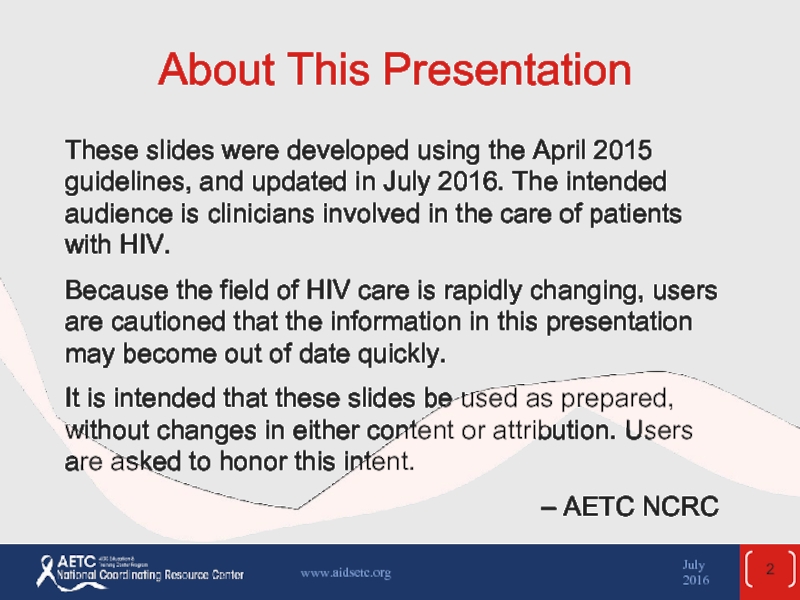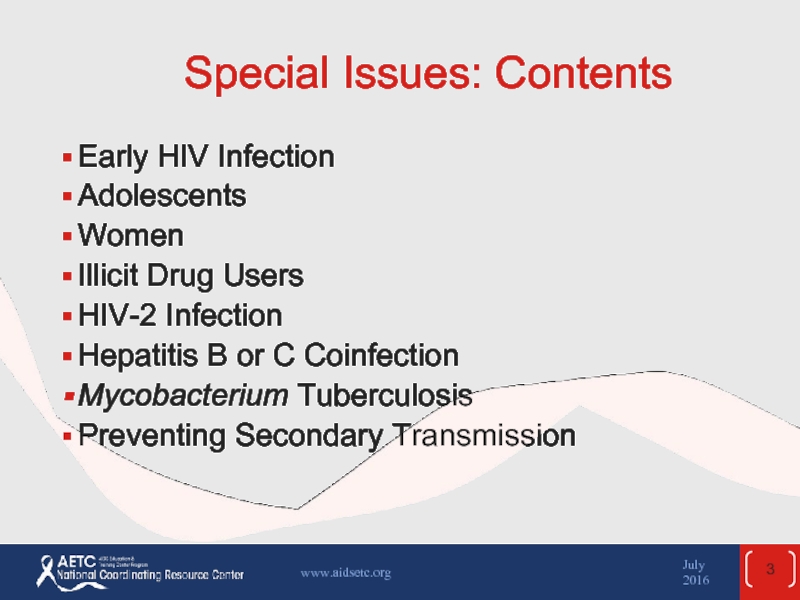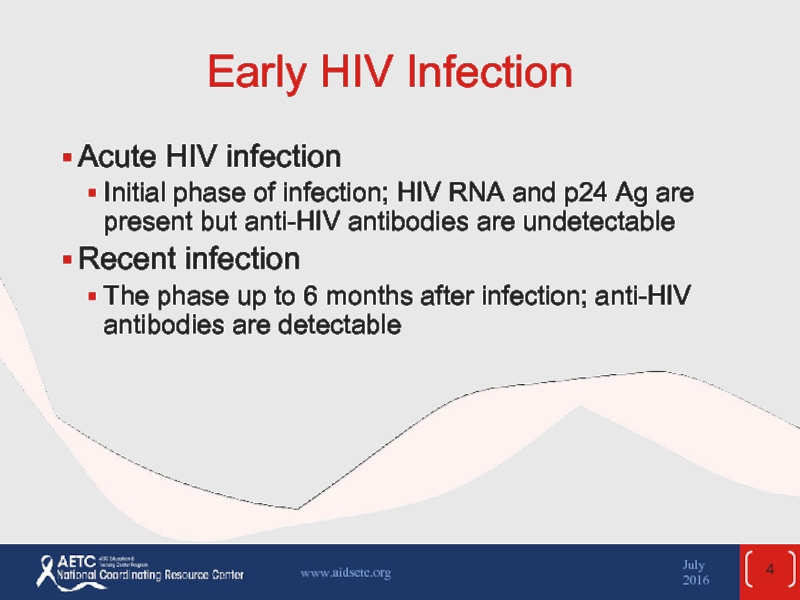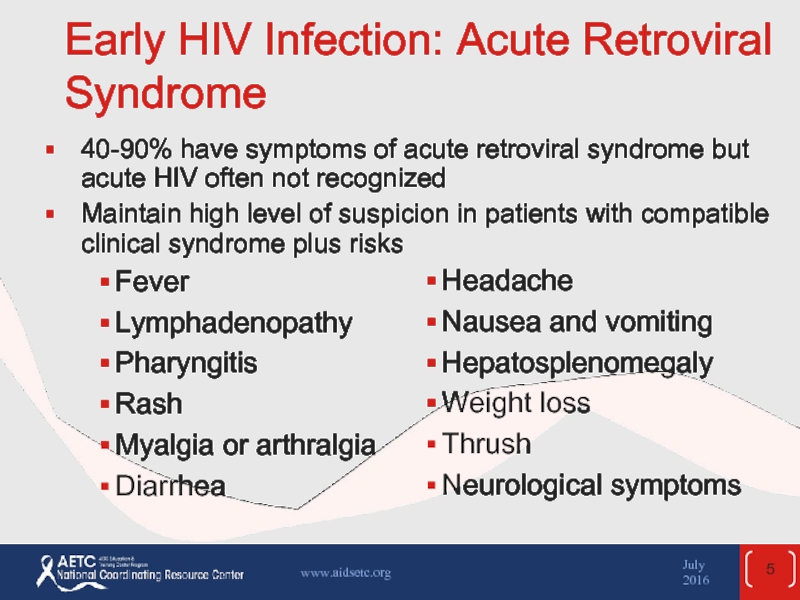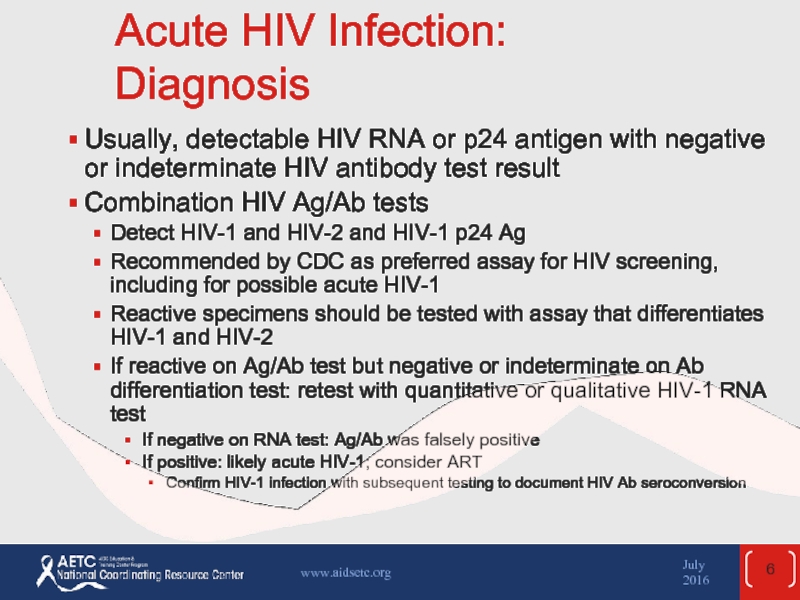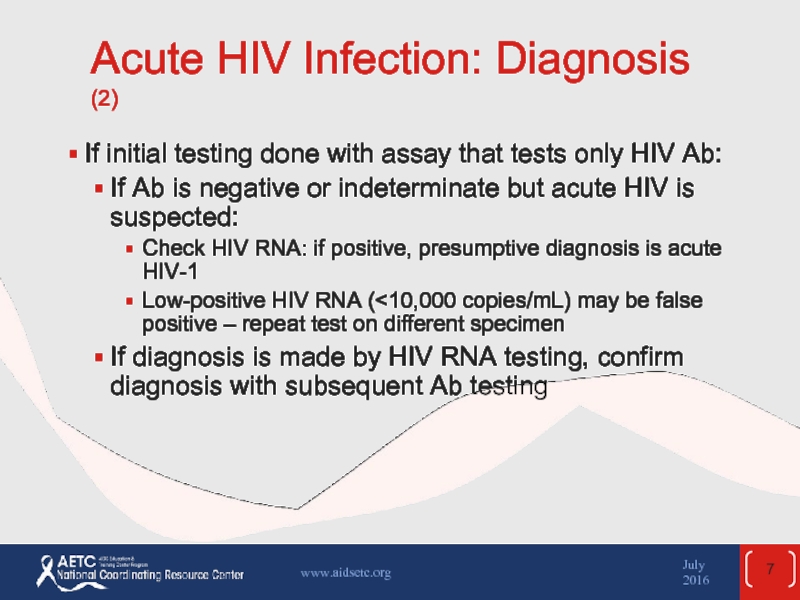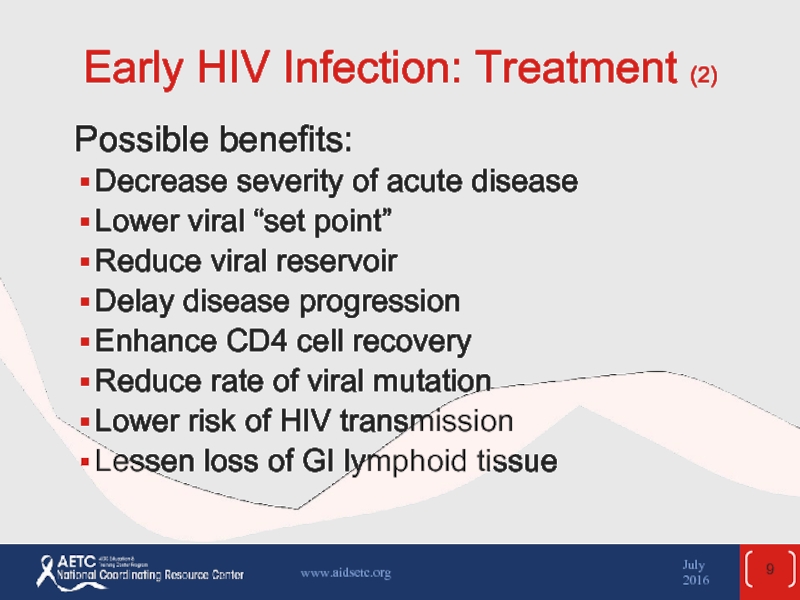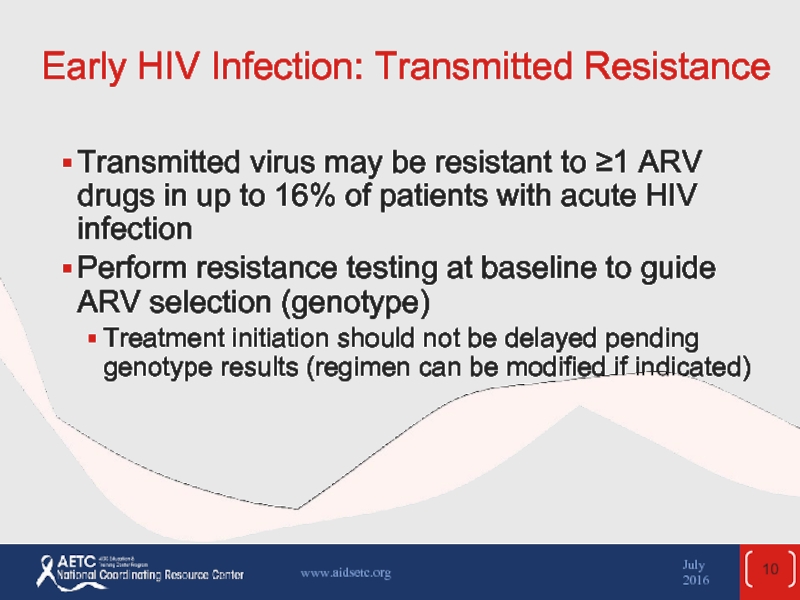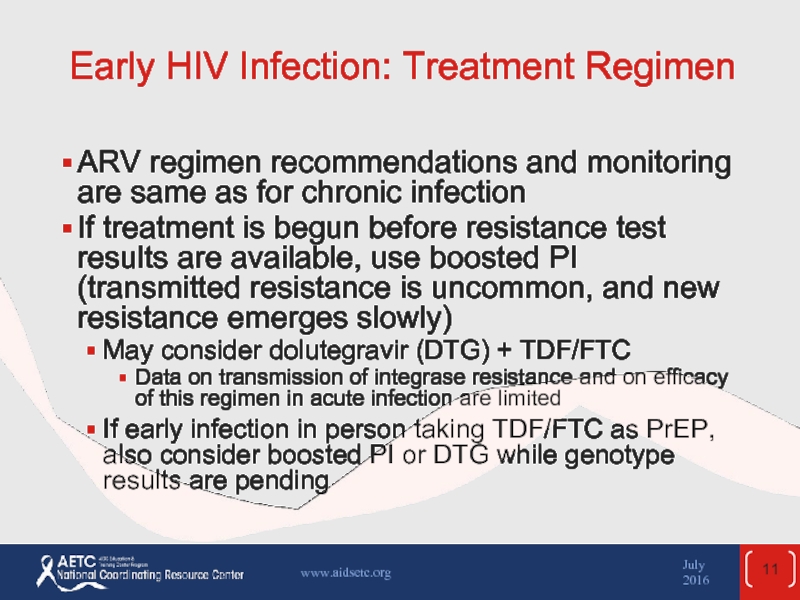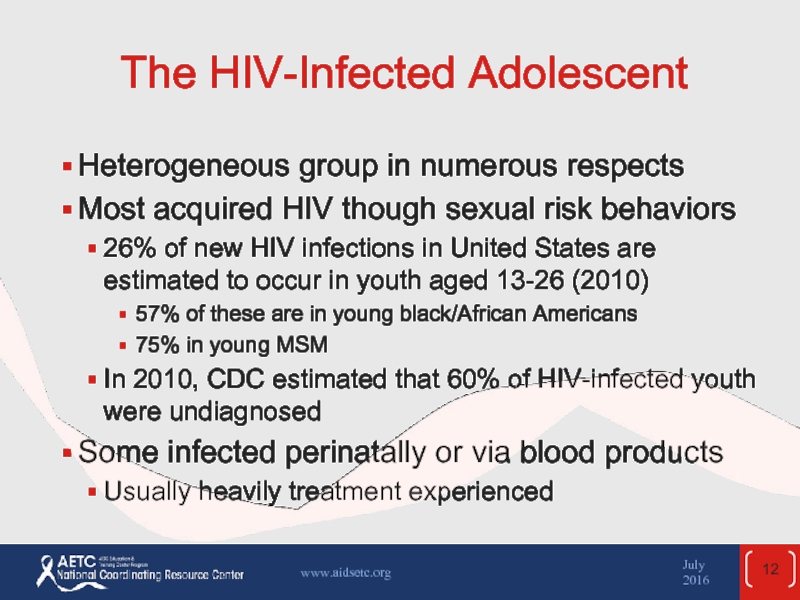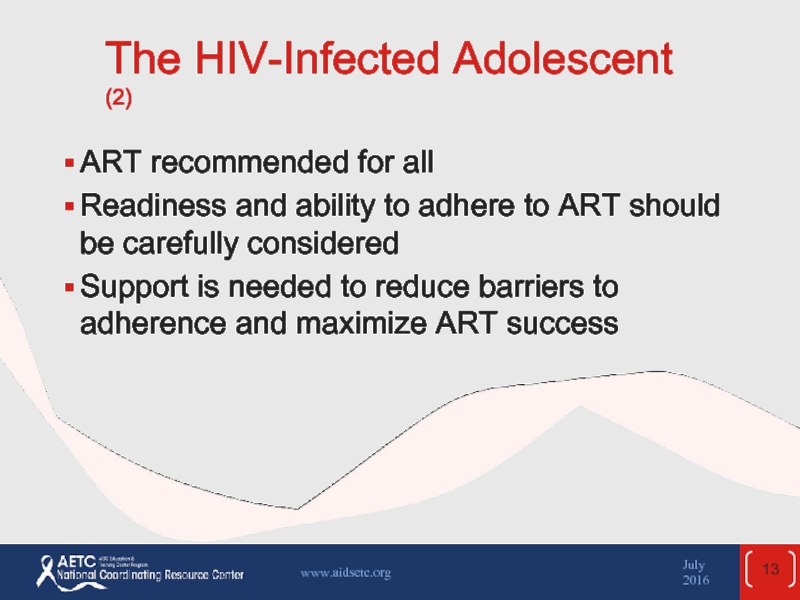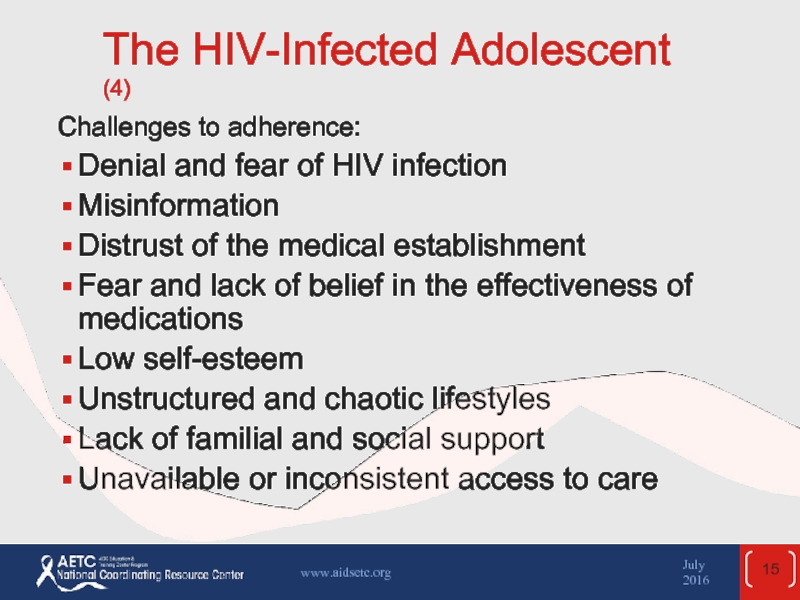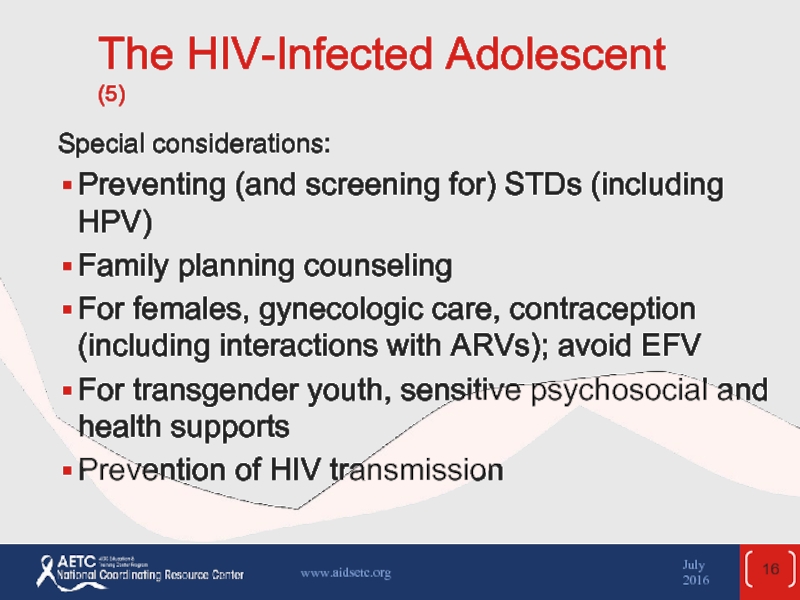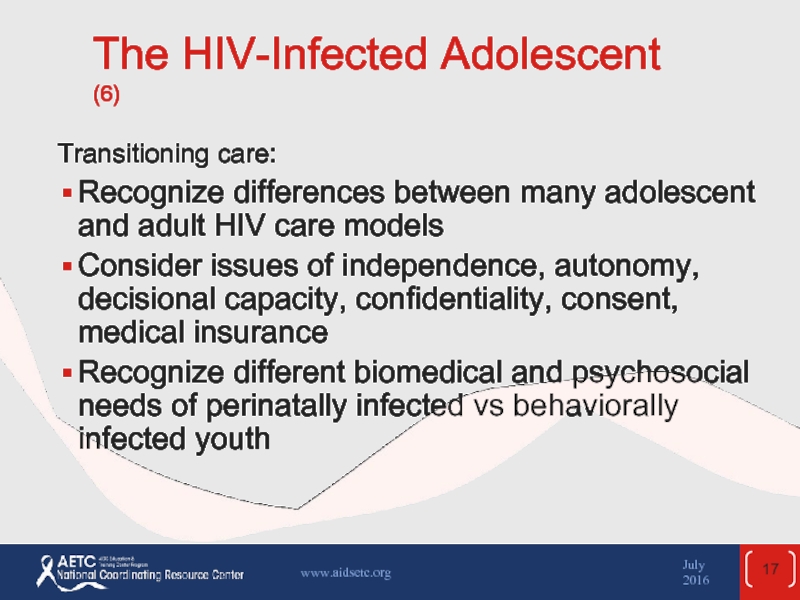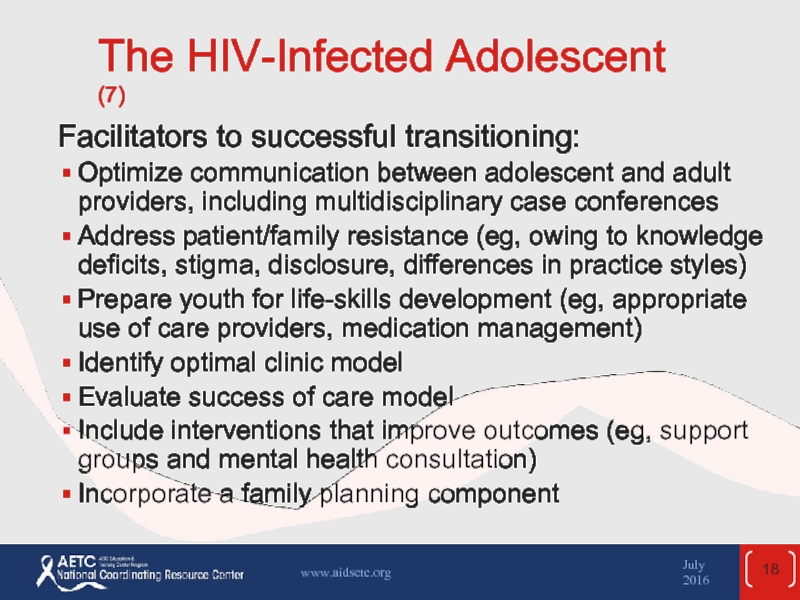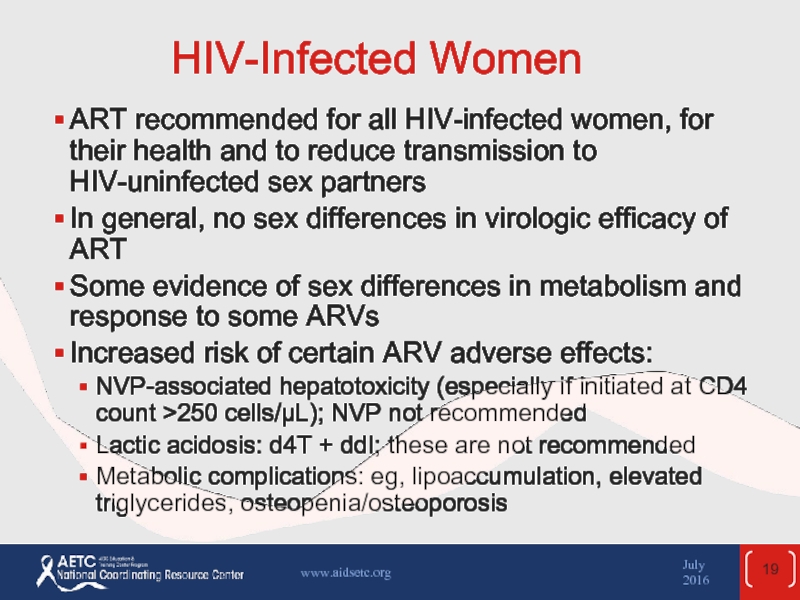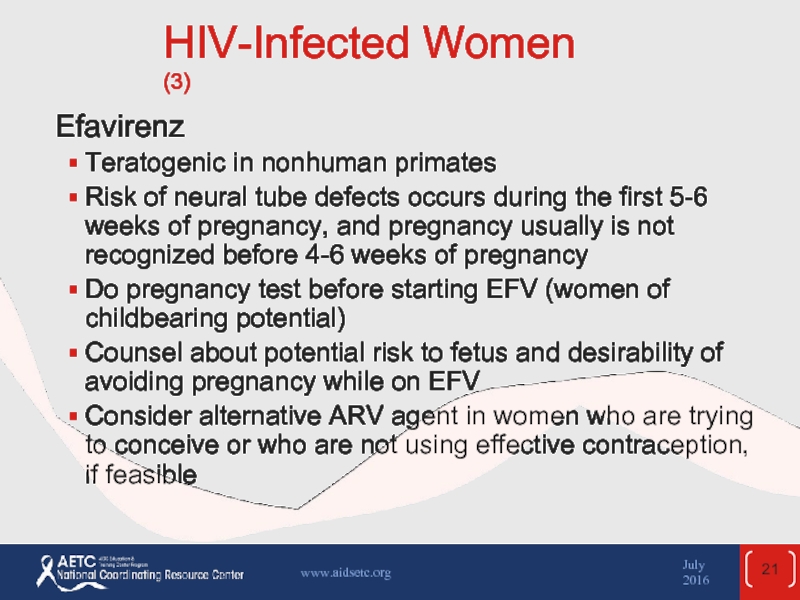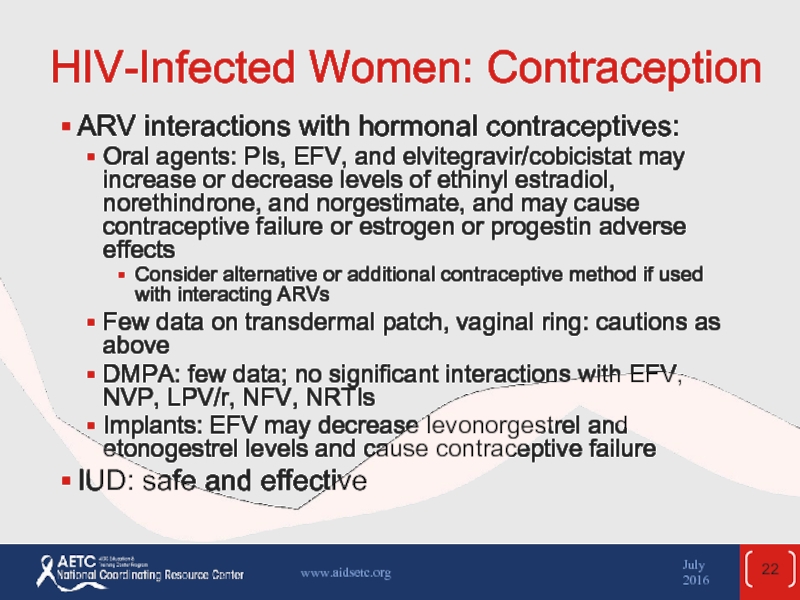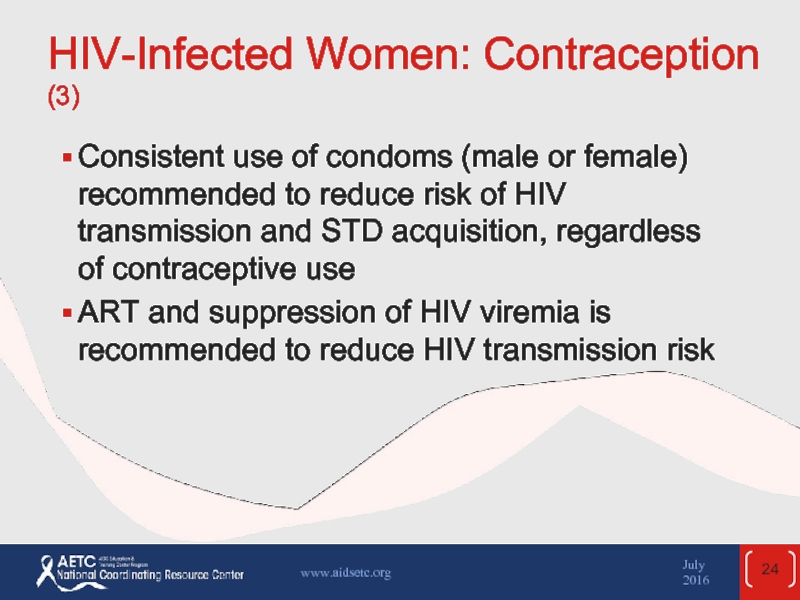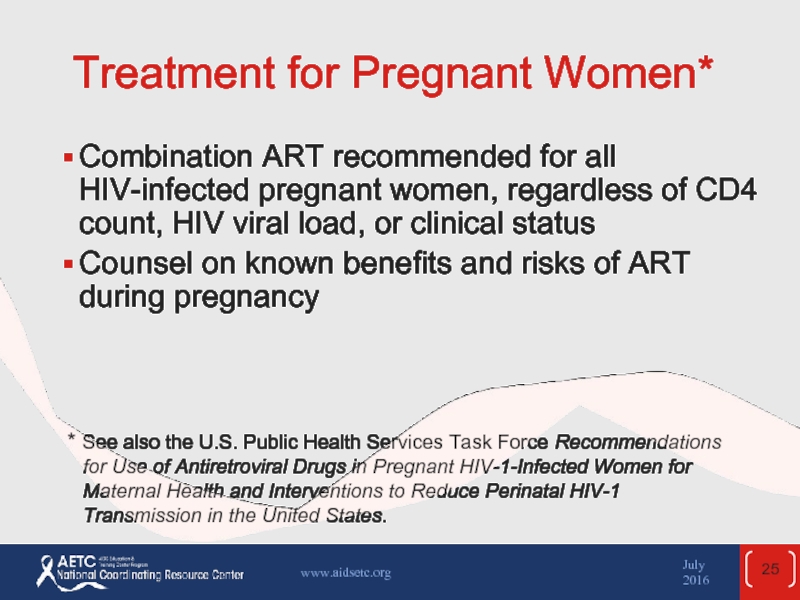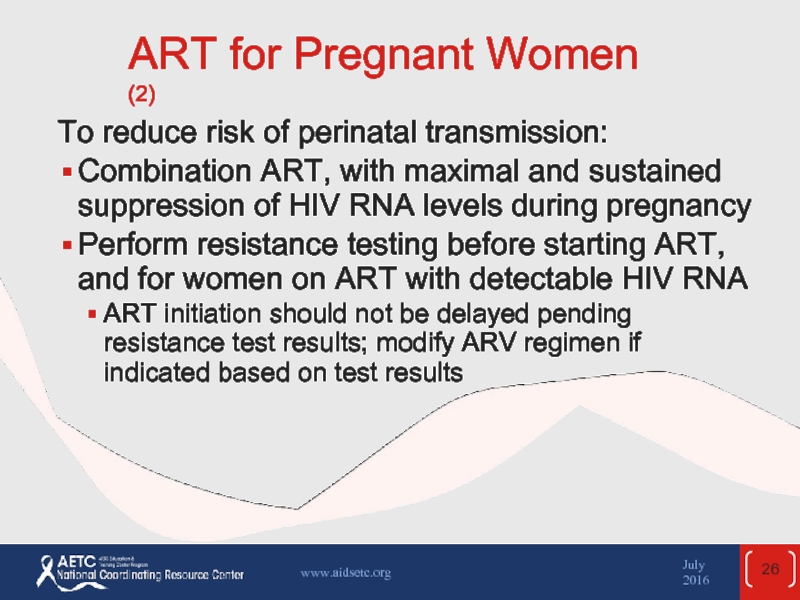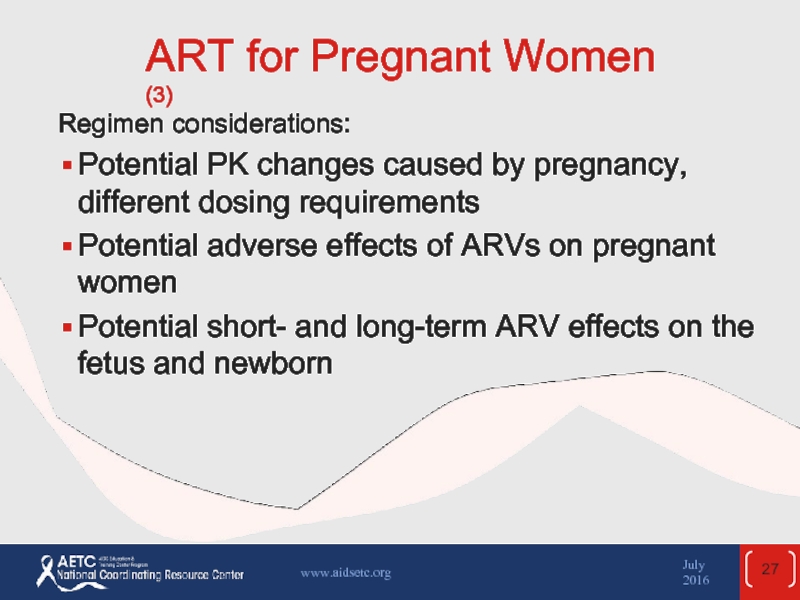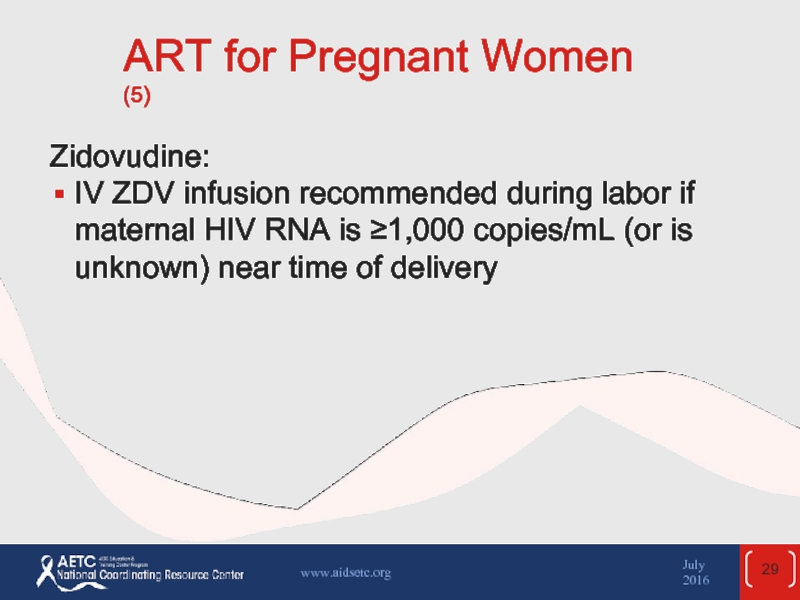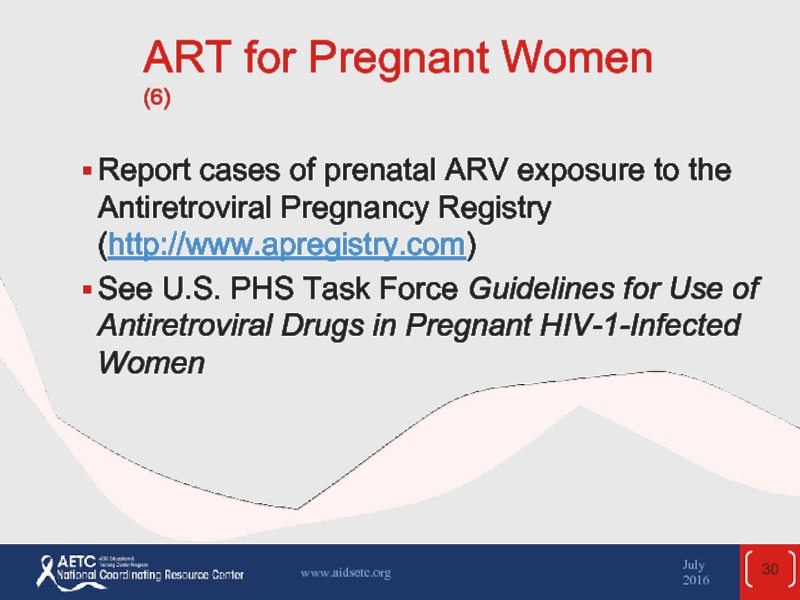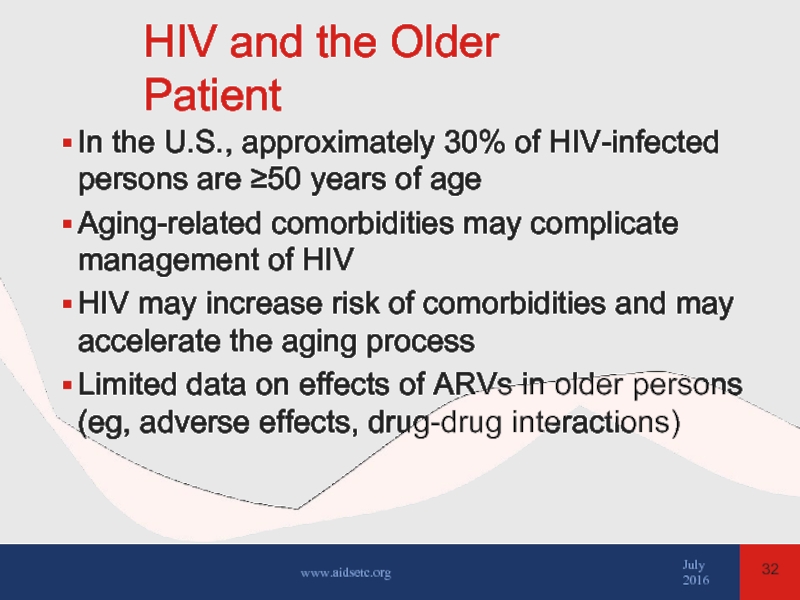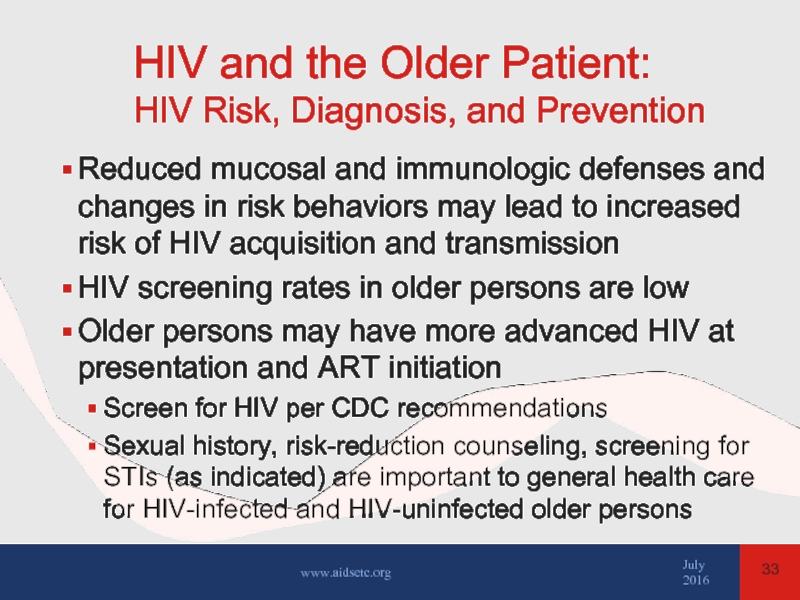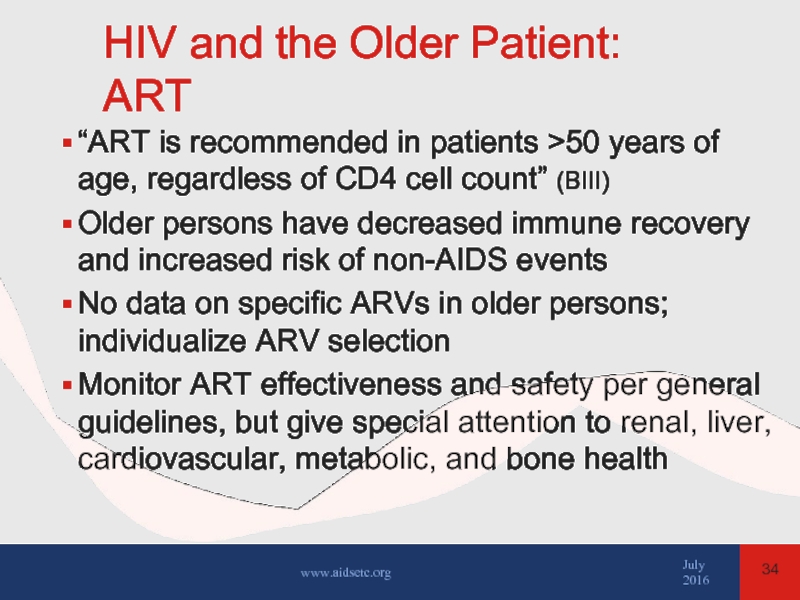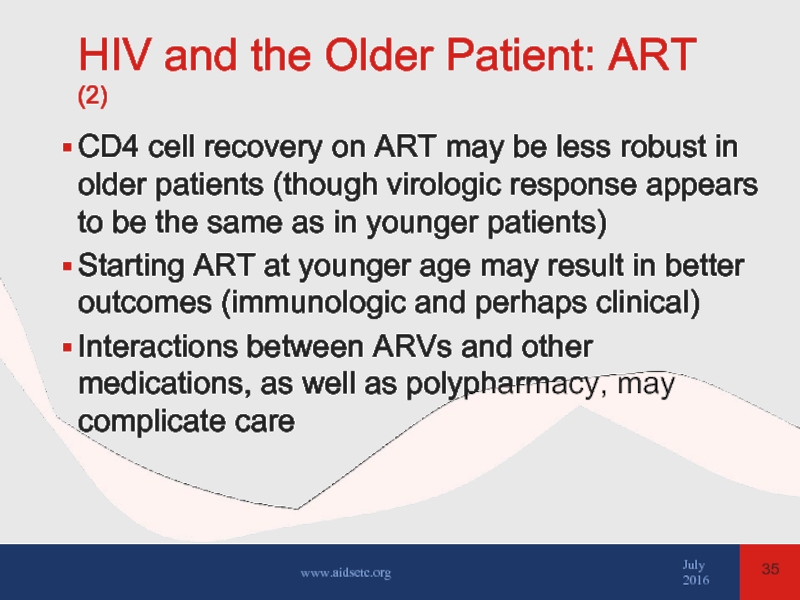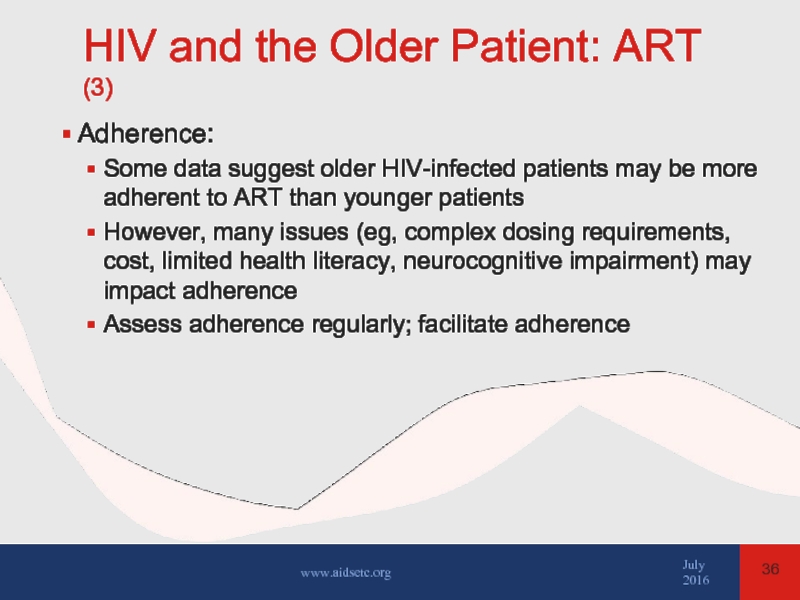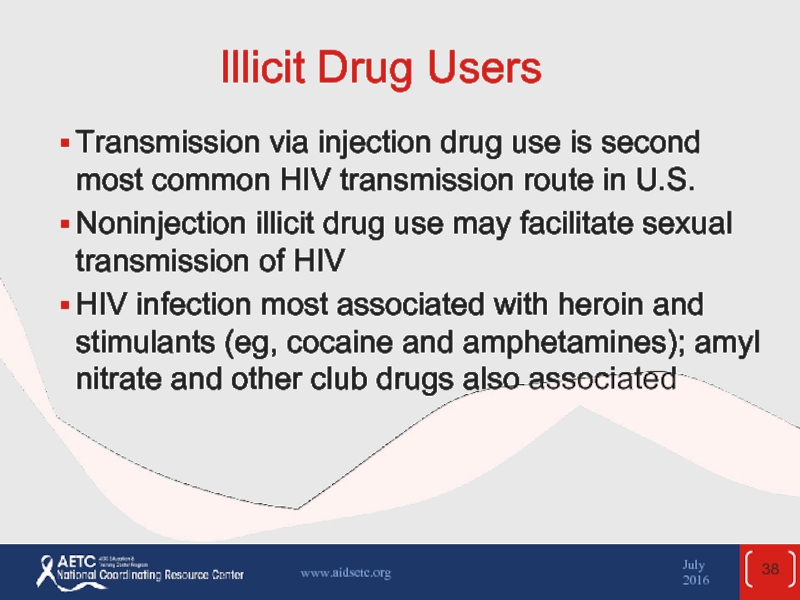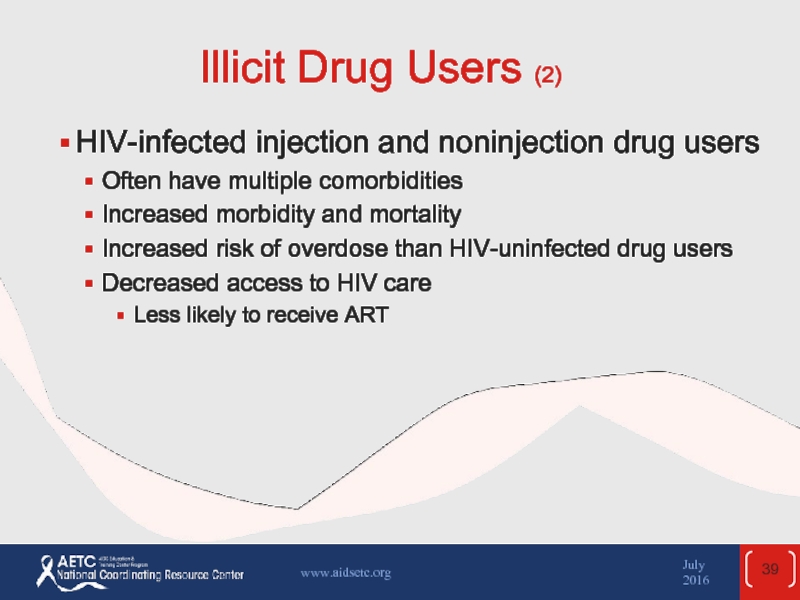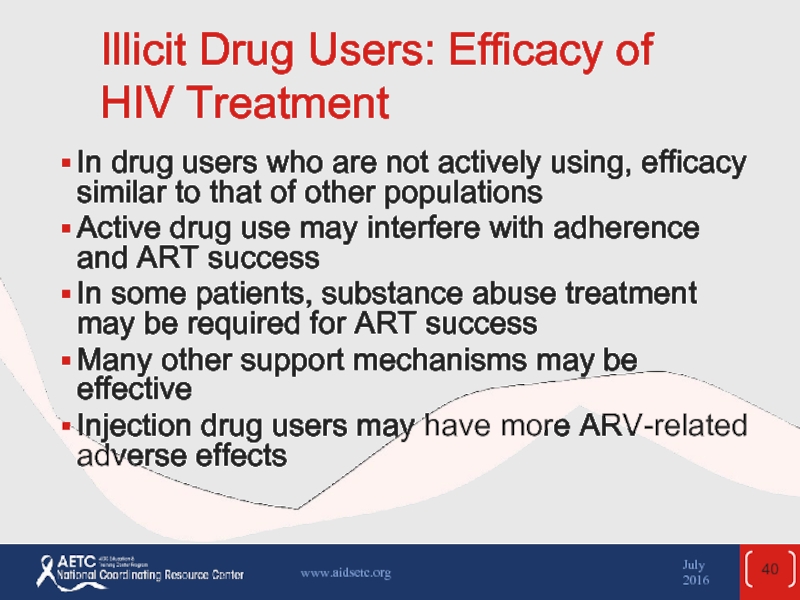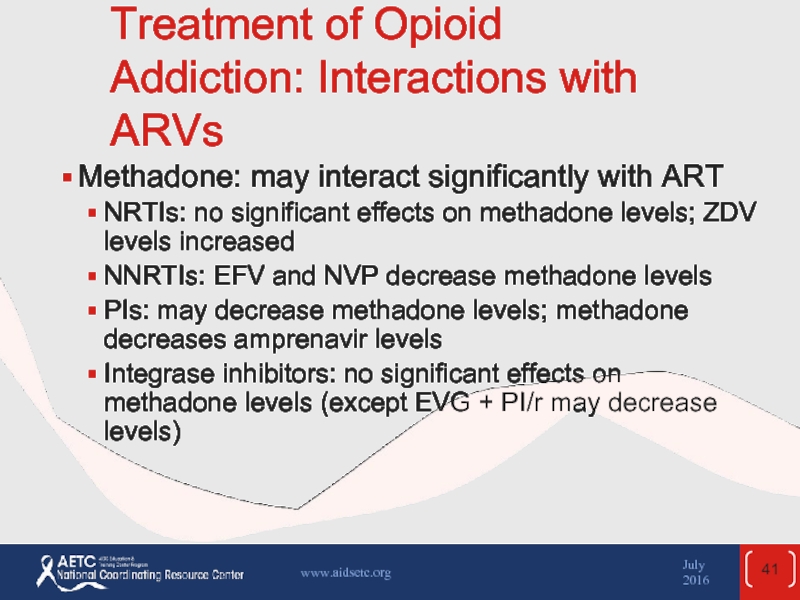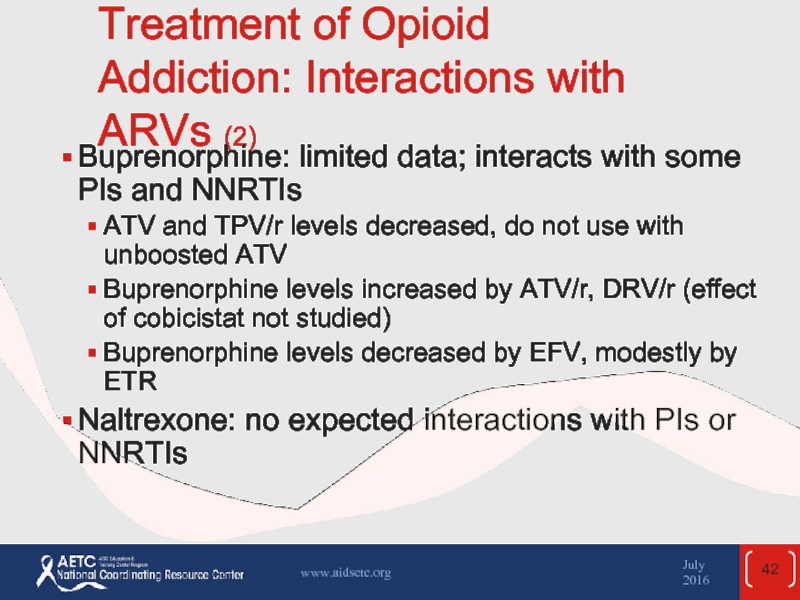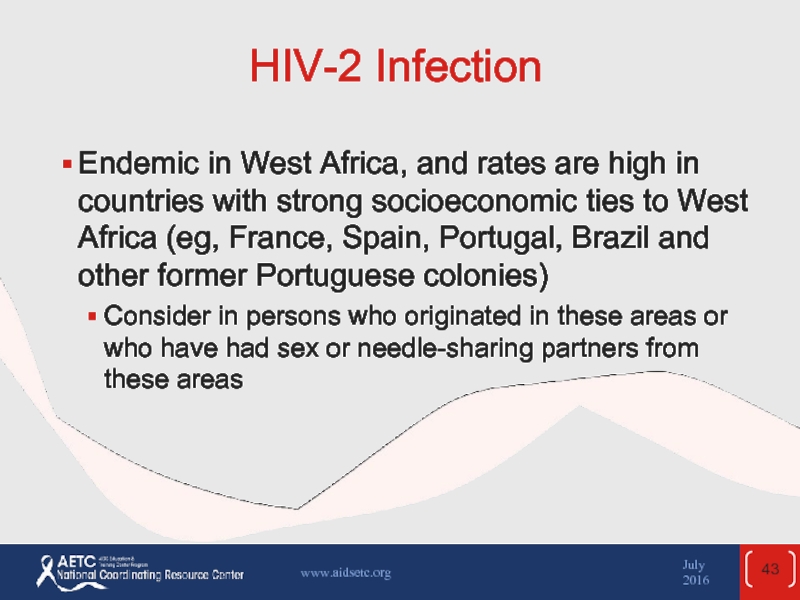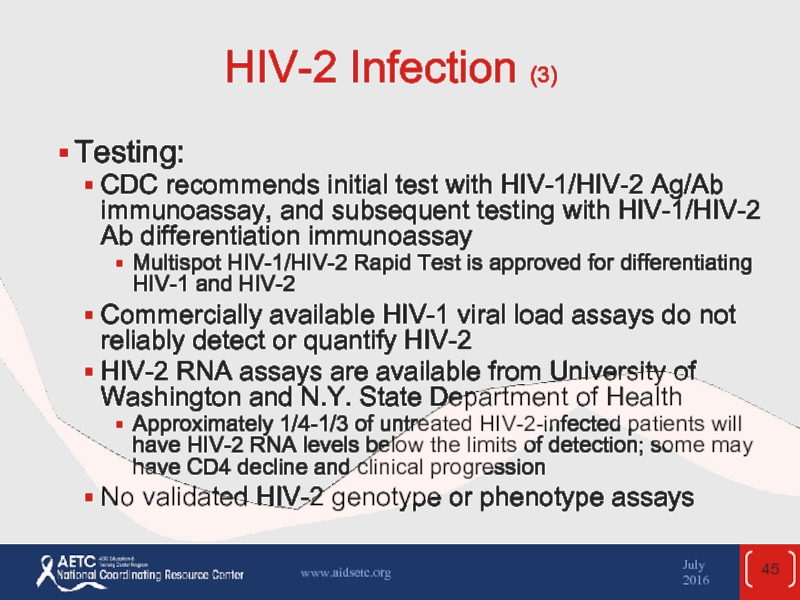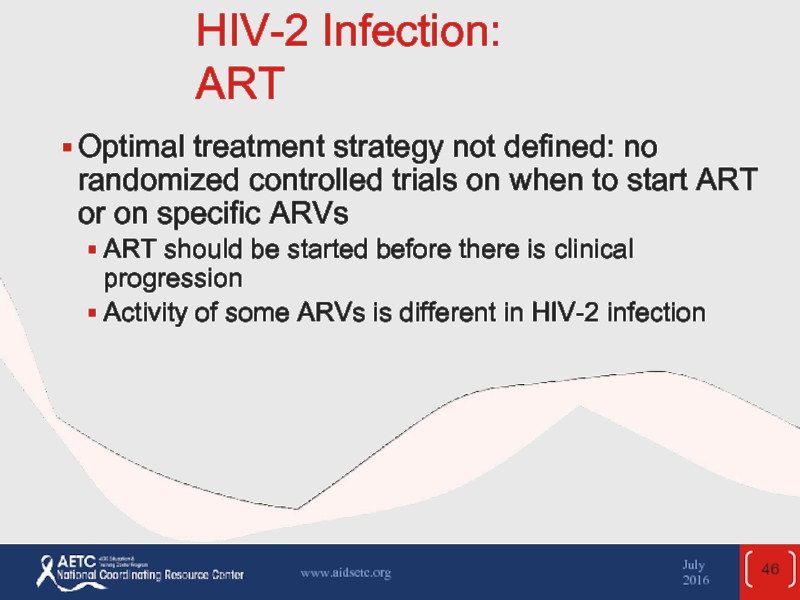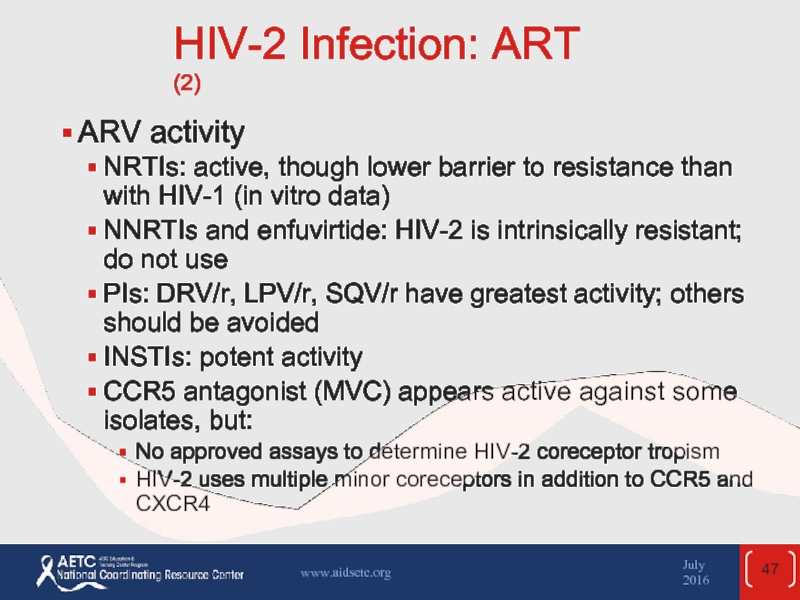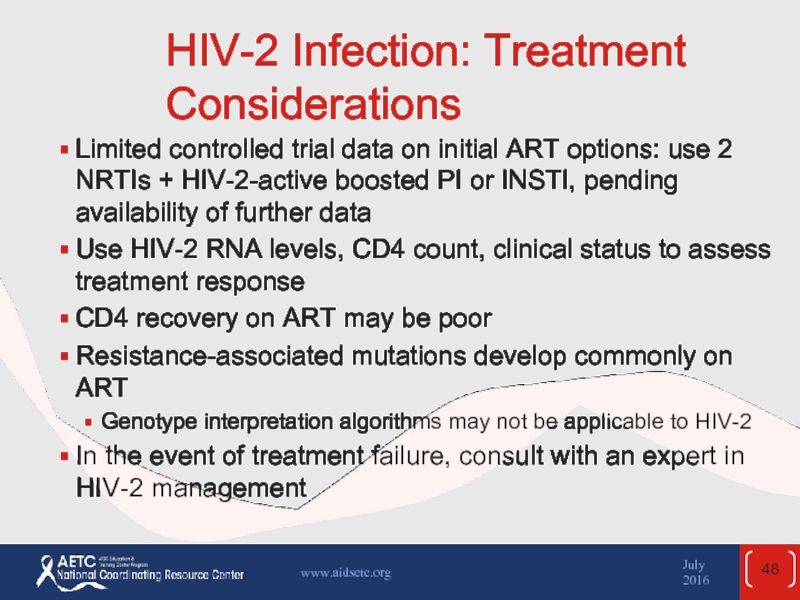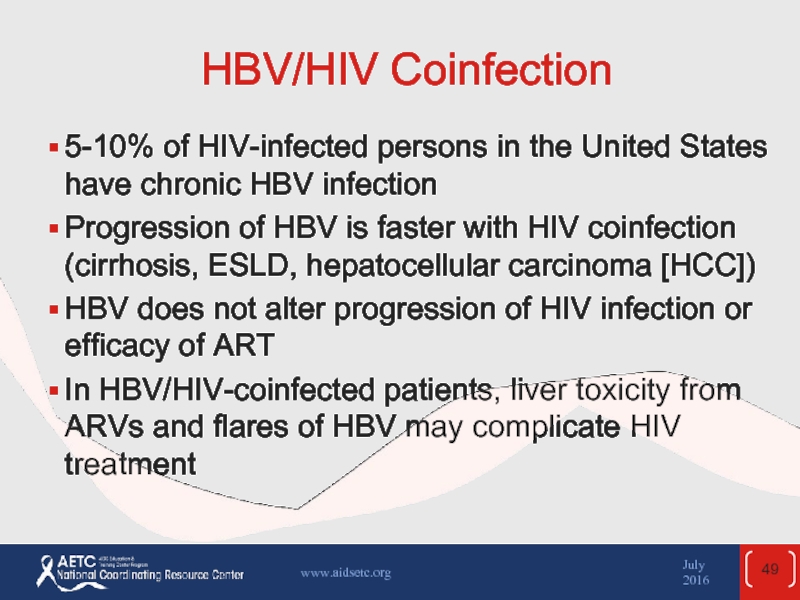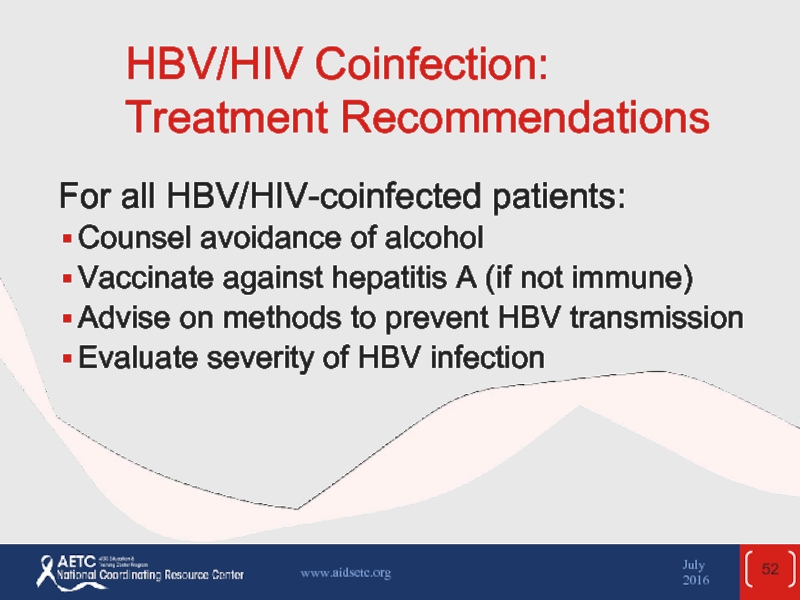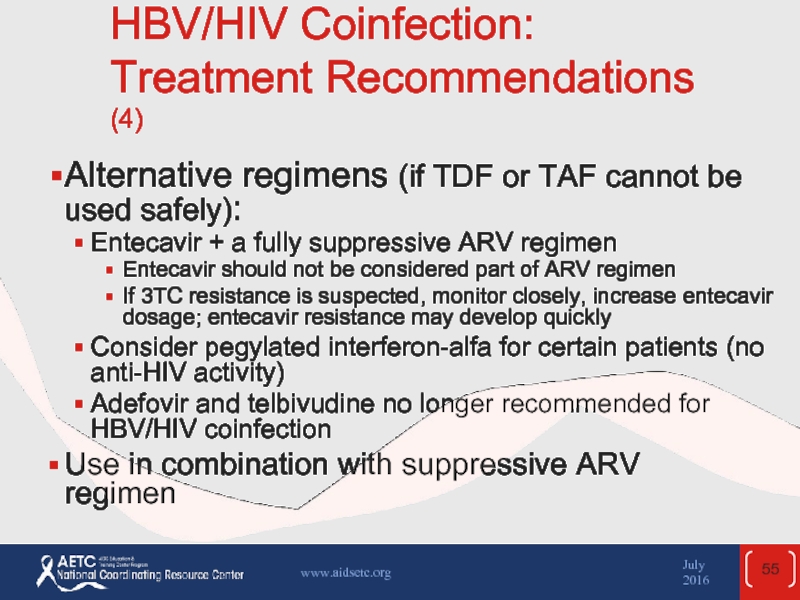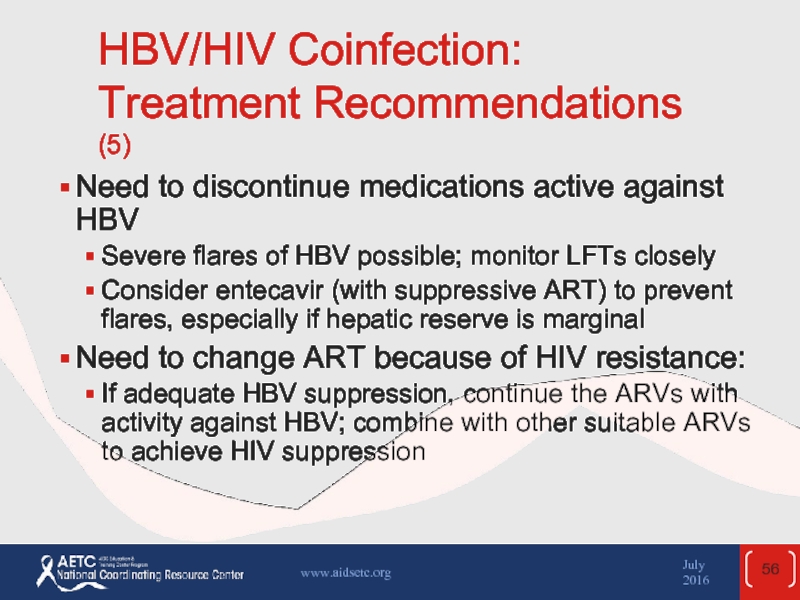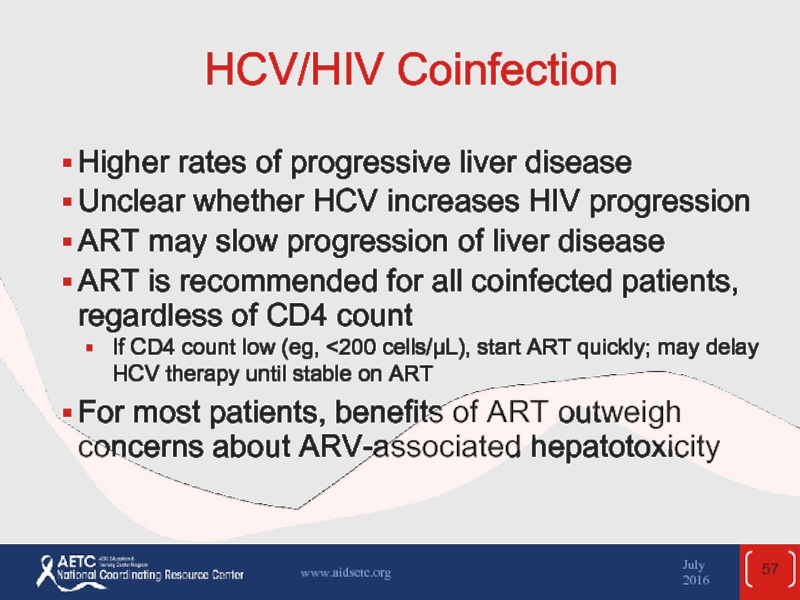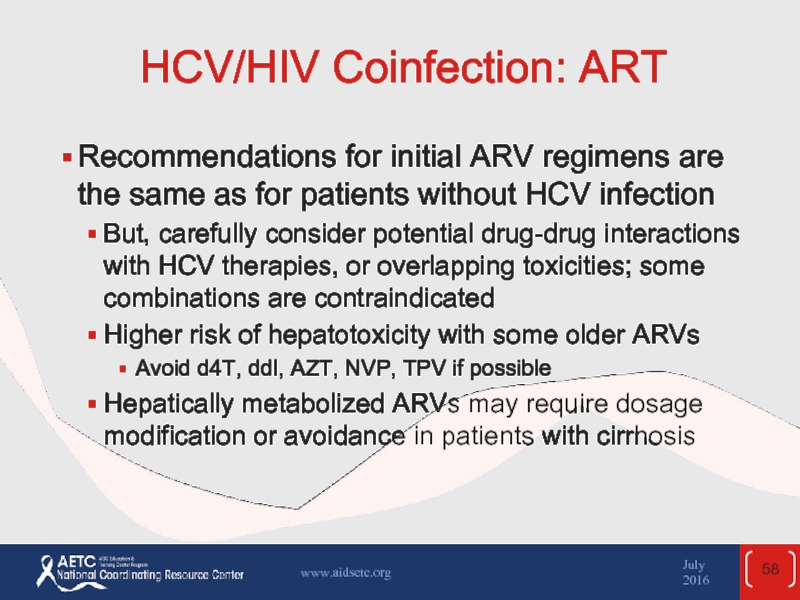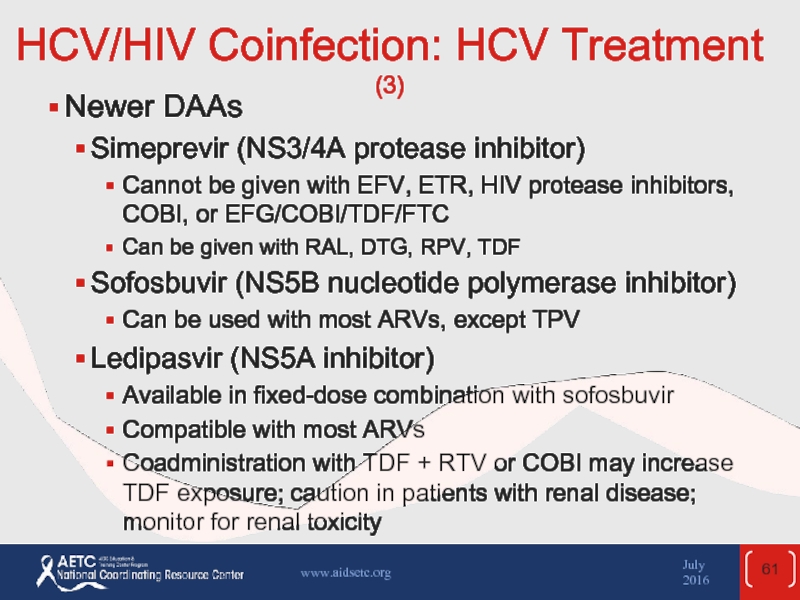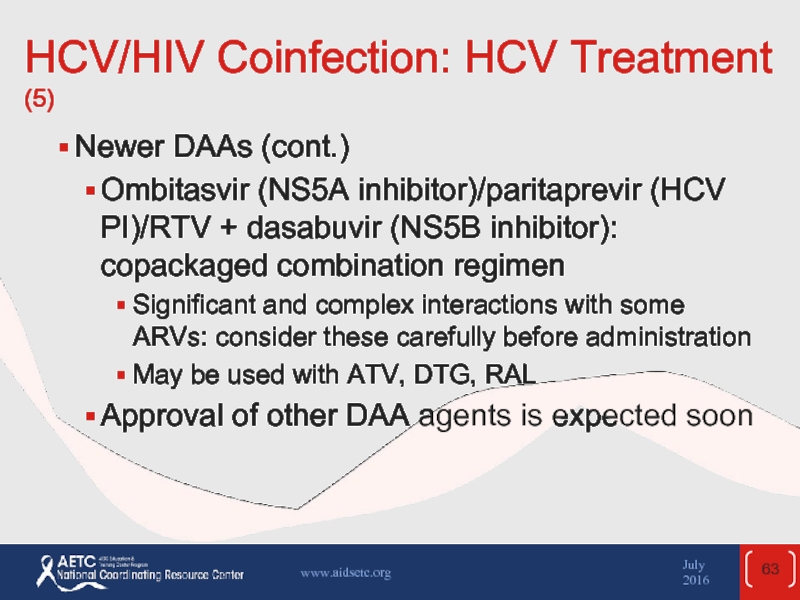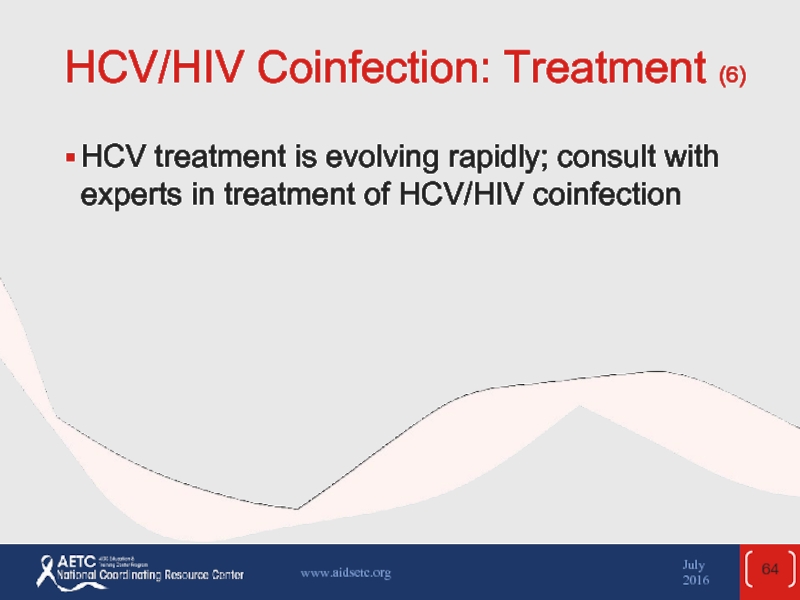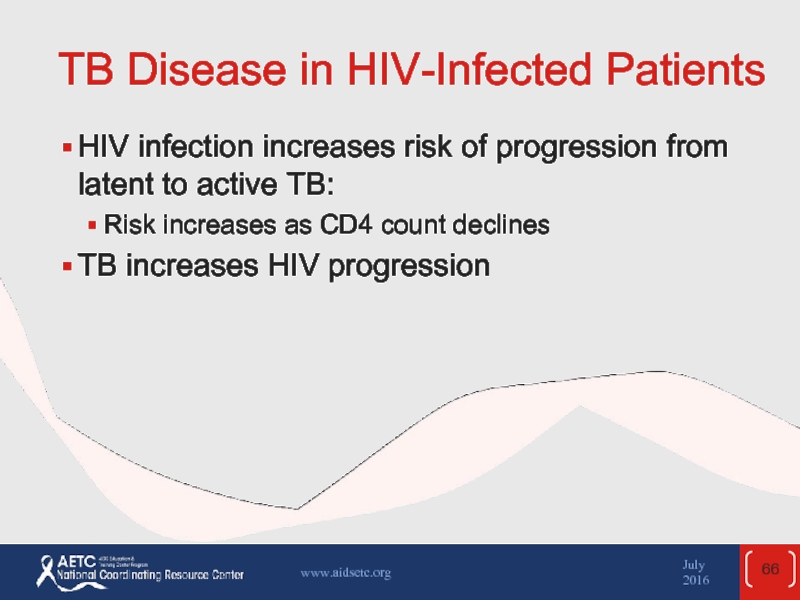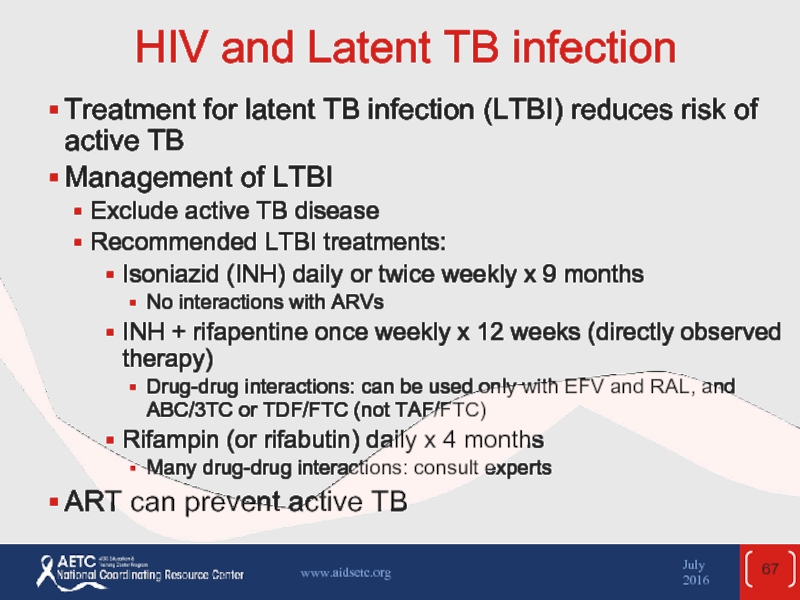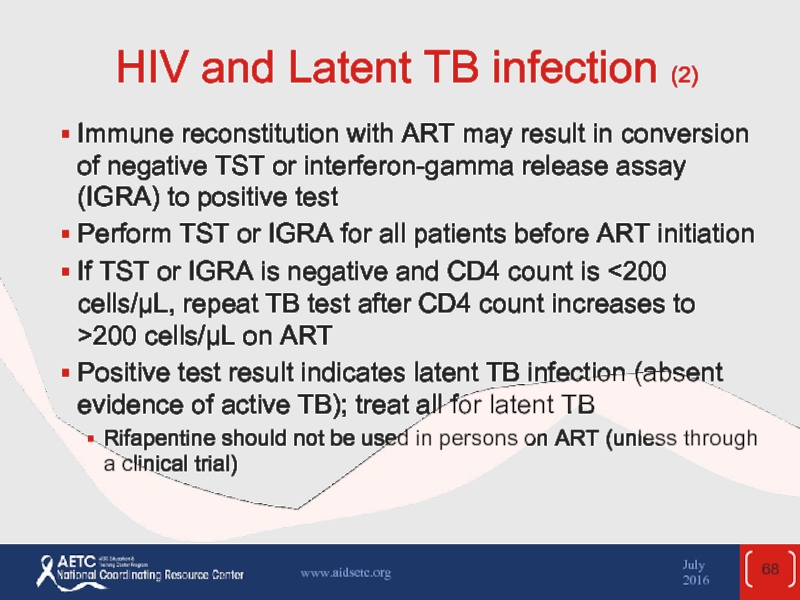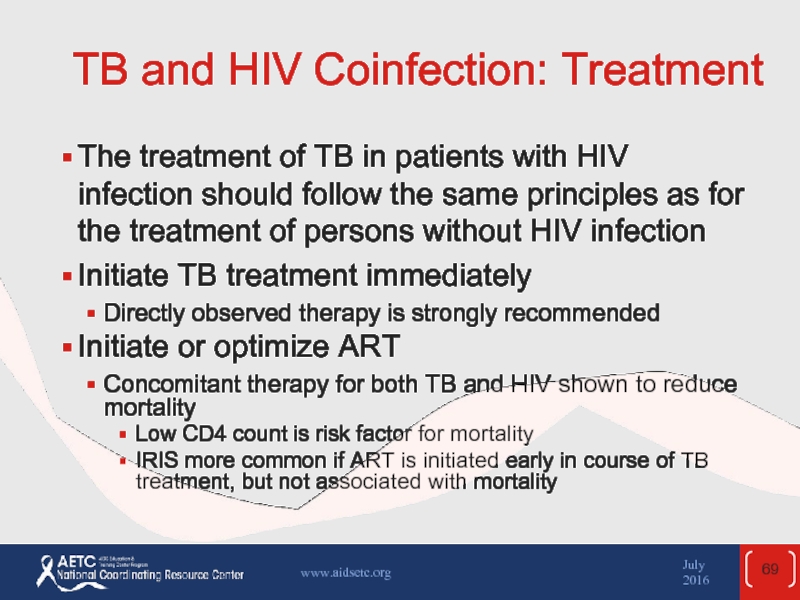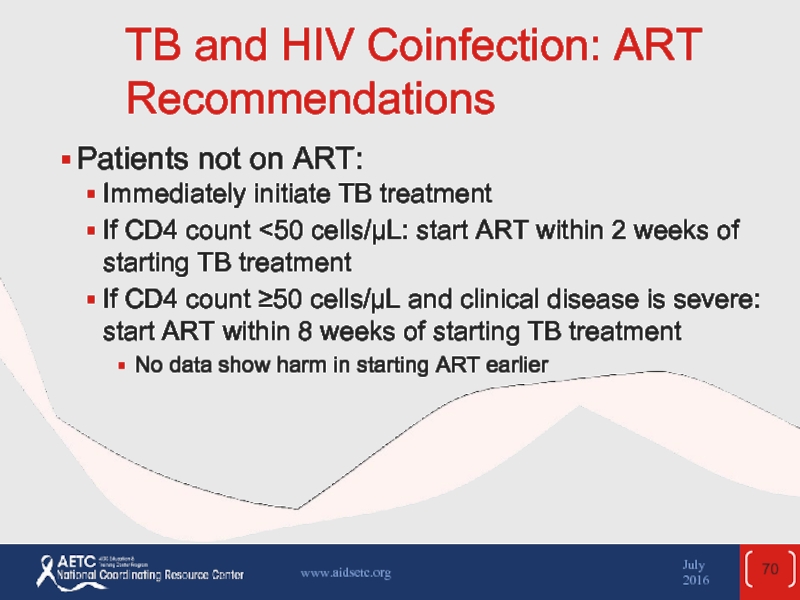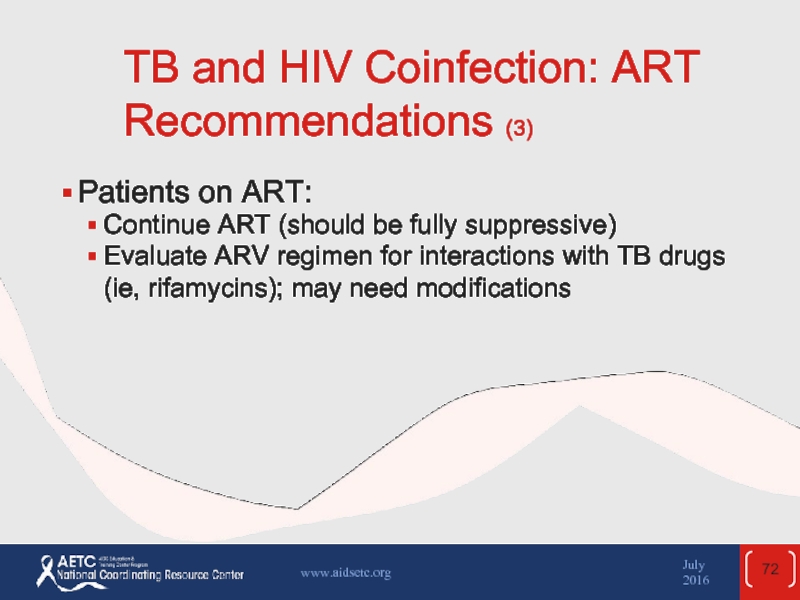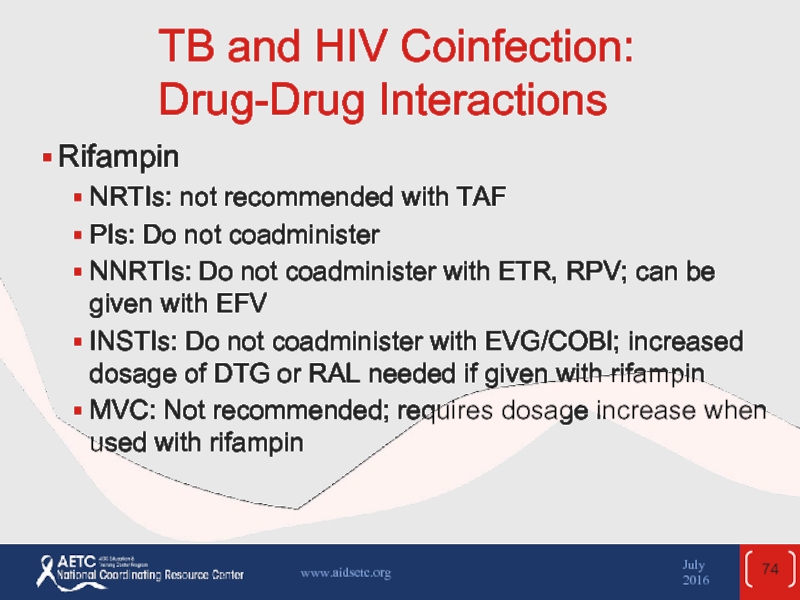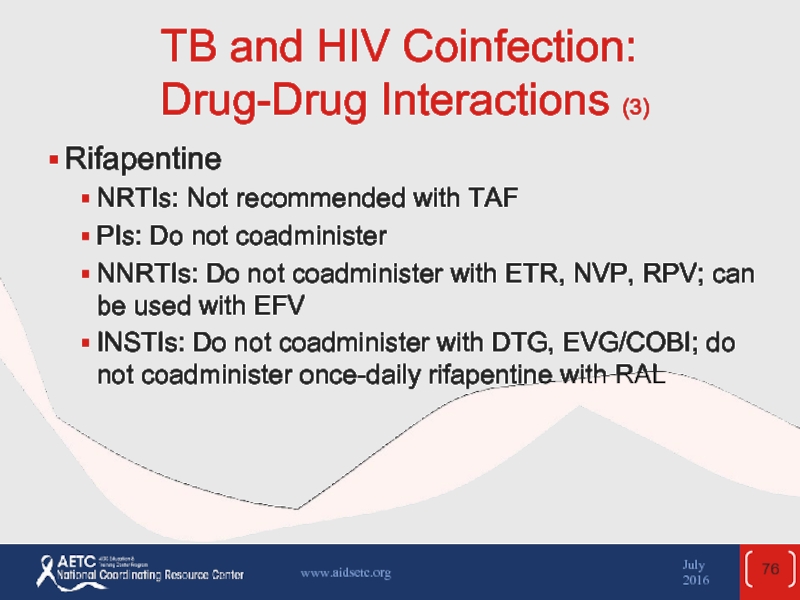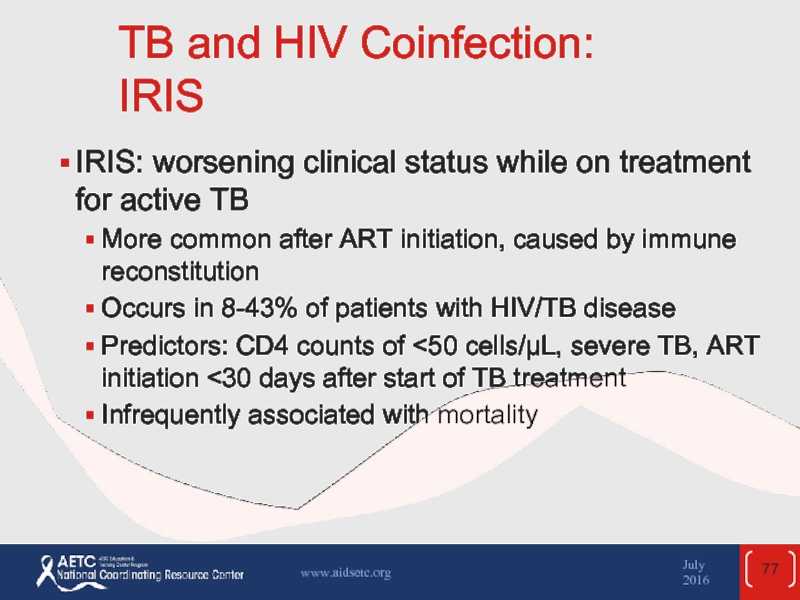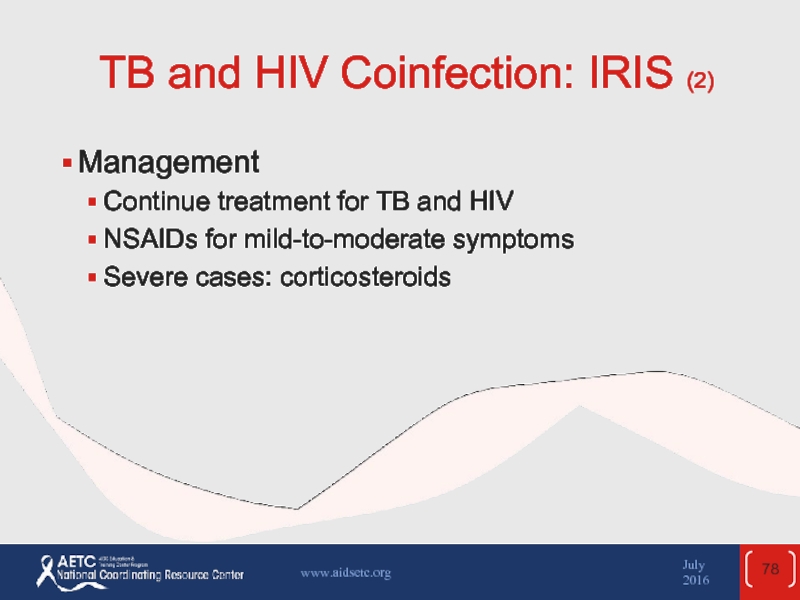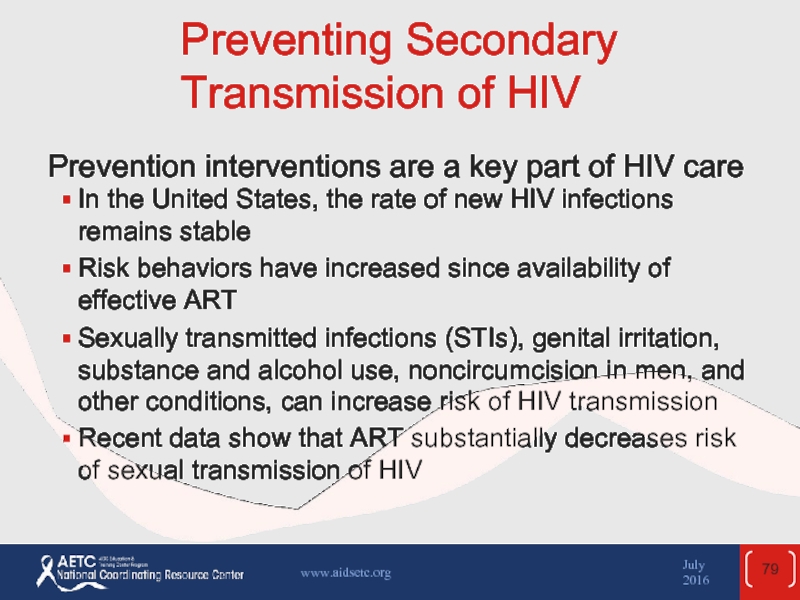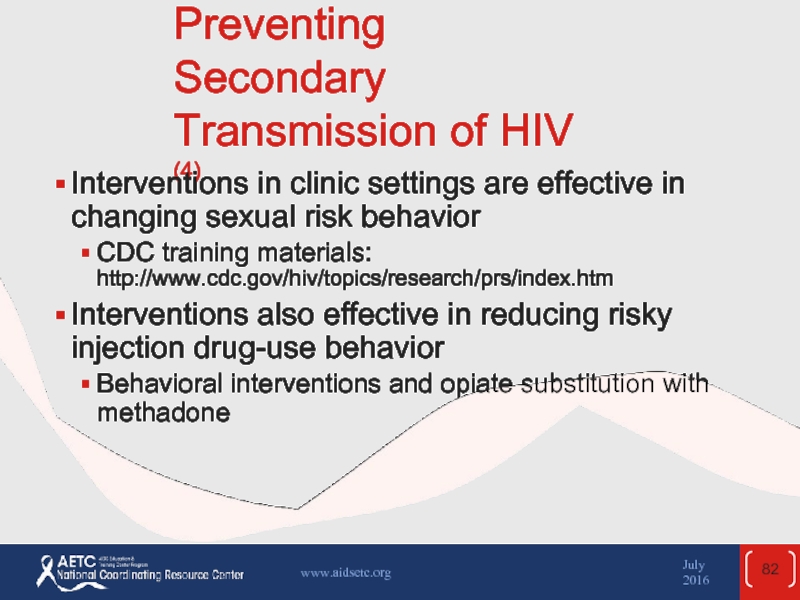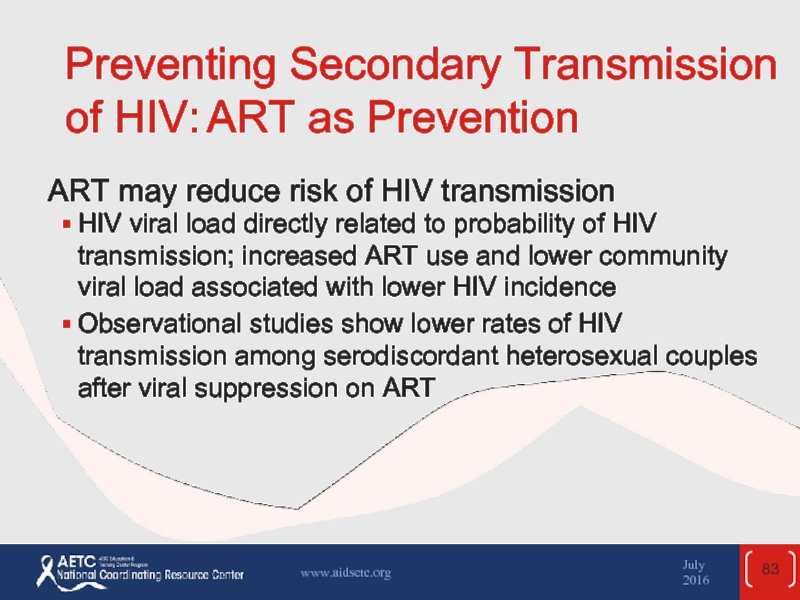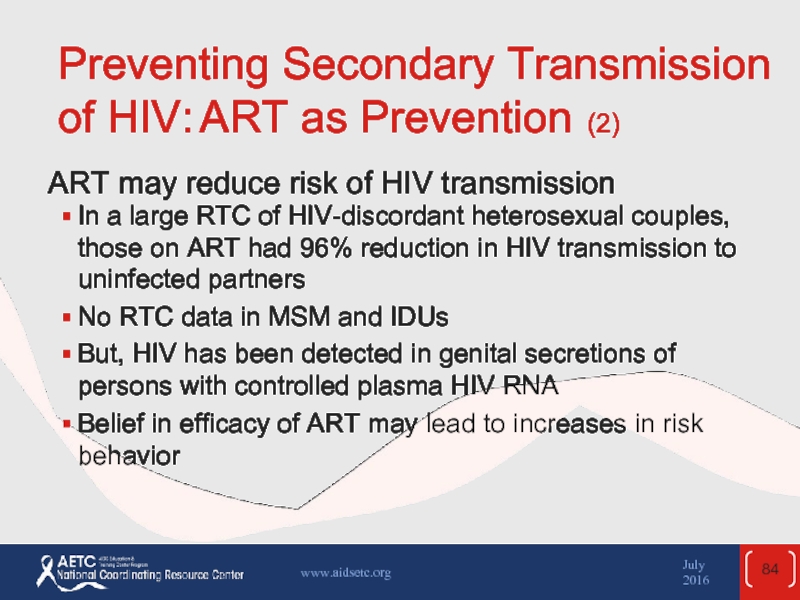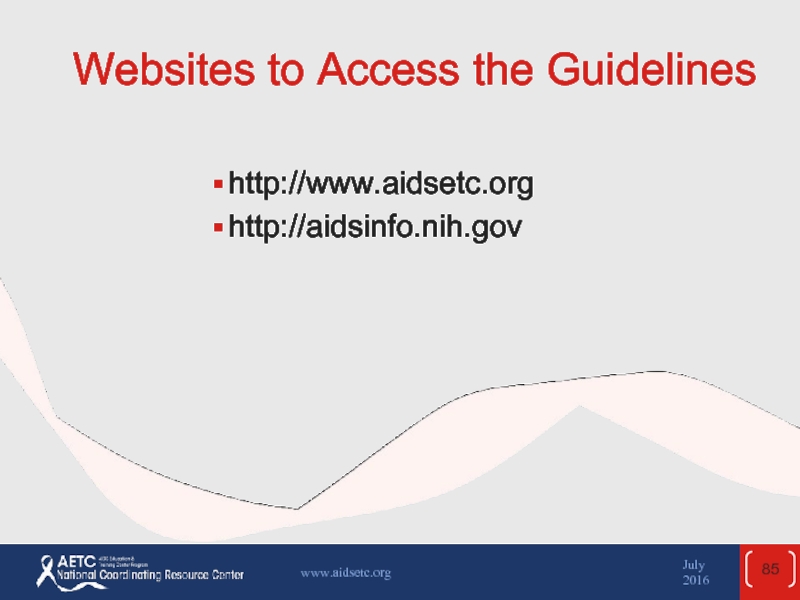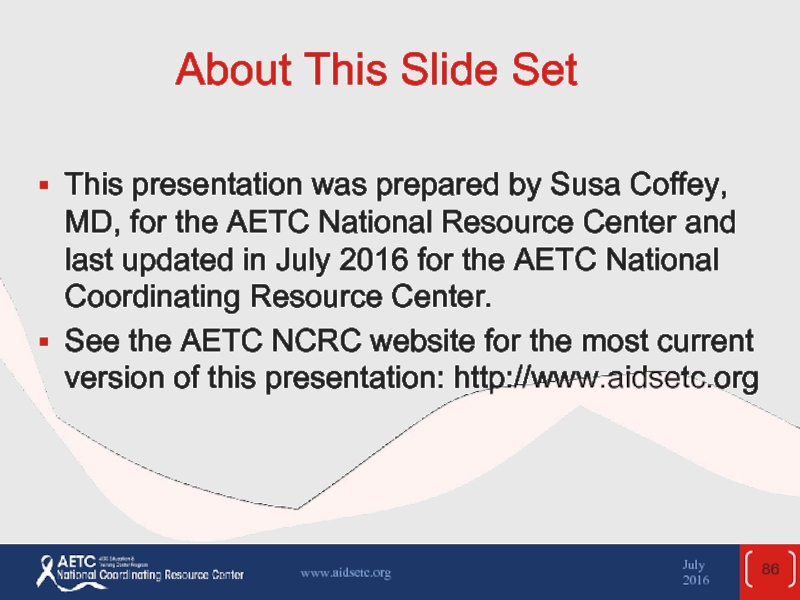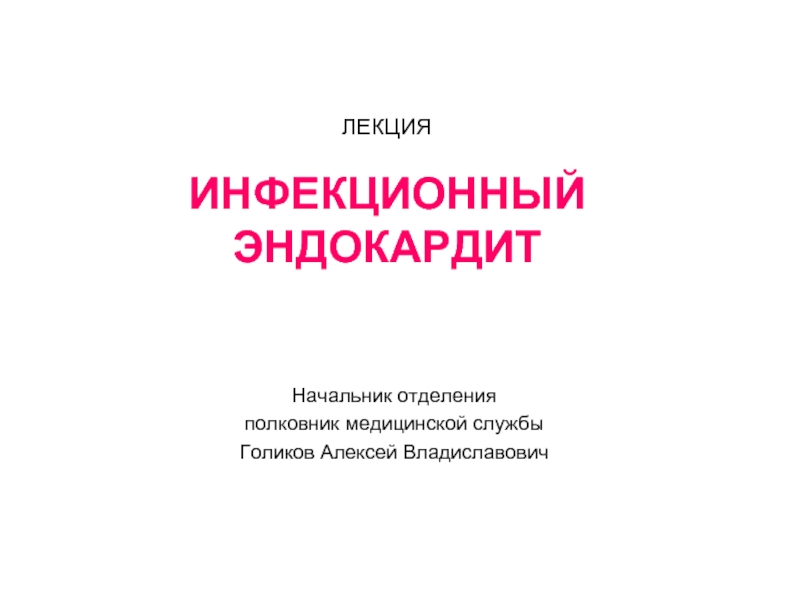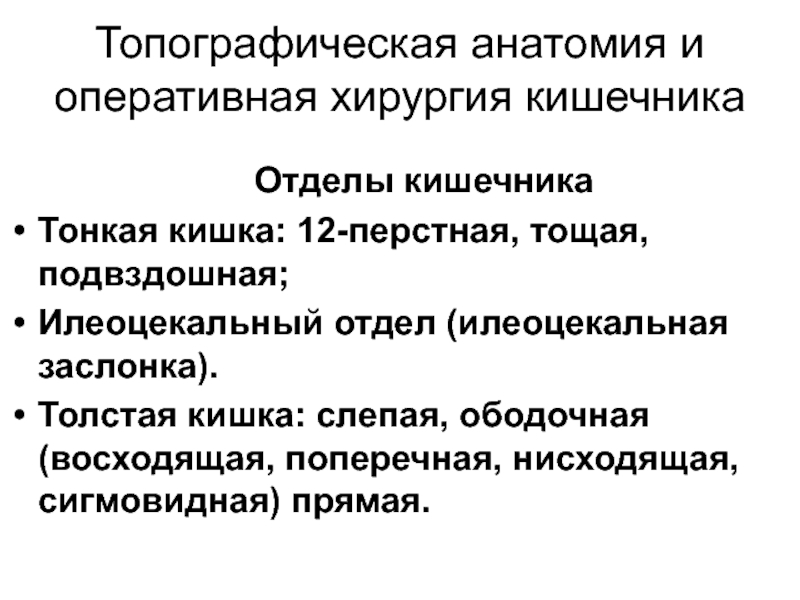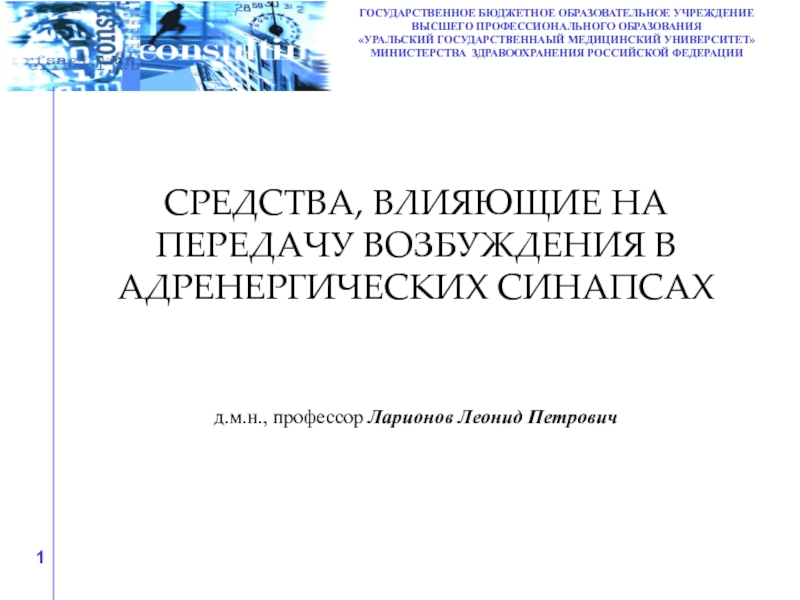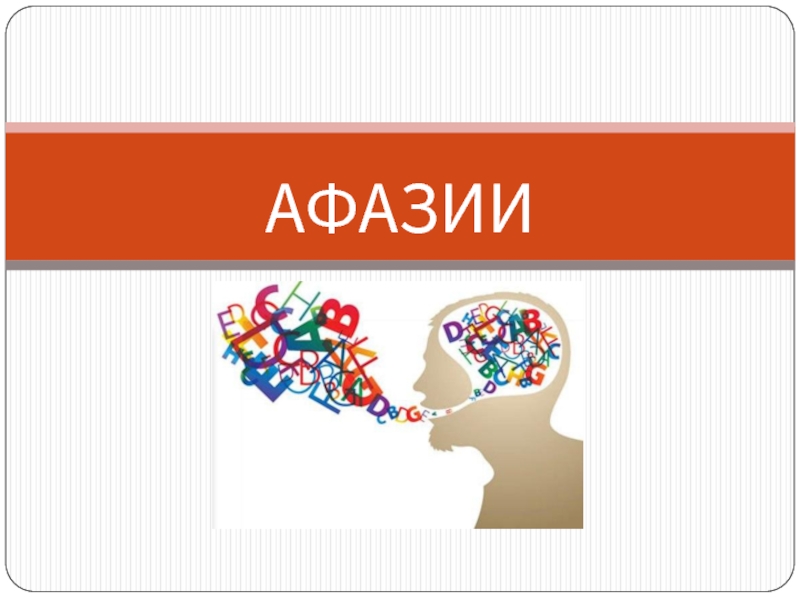- Главная
- Разное
- Дизайн
- Бизнес и предпринимательство
- Аналитика
- Образование
- Развлечения
- Красота и здоровье
- Финансы
- Государство
- Путешествия
- Спорт
- Недвижимость
- Армия
- Графика
- Культурология
- Еда и кулинария
- Лингвистика
- Английский язык
- Астрономия
- Алгебра
- Биология
- География
- Детские презентации
- Информатика
- История
- Литература
- Маркетинг
- Математика
- Медицина
- Менеджмент
- Музыка
- МХК
- Немецкий язык
- ОБЖ
- Обществознание
- Окружающий мир
- Педагогика
- Русский язык
- Технология
- Физика
- Философия
- Химия
- Шаблоны, картинки для презентаций
- Экология
- Экономика
- Юриспруденция
Special issues. Guidelines for the use of antiretroviral agents in adults and adolescents презентация
Содержание
- 1. Special issues. Guidelines for the use of antiretroviral agents in adults and adolescents
- 2. About This Presentation July 2016 www.aidsetc.org These
- 3. Special Issues: Contents Early HIV Infection
- 4. Early HIV Infection Acute HIV infection Initial
- 5. Early HIV Infection: Acute Retroviral Syndrome Fever
- 6. Acute HIV Infection: Diagnosis Usually, detectable HIV
- 7. Acute HIV Infection: Diagnosis (2) If initial
- 8. Early HIV Infection: Treatment ART recommended for
- 9. Early HIV Infection: Treatment (2) Possible benefits:
- 10. Early HIV Infection: Transmitted Resistance Transmitted virus
- 11. Early HIV Infection: Treatment Regimen ARV regimen
- 12. The HIV-Infected Adolescent Heterogeneous group in numerous
- 13. The HIV-Infected Adolescent (2) ART recommended for
- 14. The HIV-Infected Adolescent (3) Adult guidelines for
- 15. The HIV-Infected Adolescent (4) Challenges to adherence:
- 16. The HIV-Infected Adolescent (5) Special considerations: Preventing
- 17. The HIV-Infected Adolescent (6) Transitioning care: Recognize
- 18. The HIV-Infected Adolescent (7) Facilitators to successful
- 19. HIV-Infected Women ART recommended for all HIV-infected
- 20. HIV-Infected Women (2) Women of childbearing potential
- 21. HIV-Infected Women (3) Efavirenz Teratogenic in nonhuman
- 22. HIV-Infected Women: Contraception ARV interactions with hormonal
- 23. HIV-Infected Women: Contraception (2) Hormonal contraception and
- 24. HIV-Infected Women: Contraception (3) Consistent use of
- 25. Treatment for Pregnant Women* Combination ART recommended
- 26. ART for Pregnant Women (2) To reduce
- 27. ART for Pregnant Women (3) Regimen considerations:
- 28. ART for Pregnant Women (4) Efavirenz Risk
- 29. ART for Pregnant Women (5) Zidovudine: IV
- 30. ART for Pregnant Women (6) Report cases
- 31. Postpartum Management Continue ART after delivery, as
- 32. HIV and the Older Patient In the
- 33. HIV and the Older Patient: HIV Risk,
- 34. HIV and the Older Patient: ART “ART
- 35. HIV and the Older Patient: ART (2)
- 36. HIV and the Older Patient: ART (3)
- 37. HIV and the Older Patient: Complications and
- 38. Illicit Drug Users Transmission via injection
- 39. Illicit Drug Users (2) HIV-infected injection
- 40. Illicit Drug Users: Efficacy of HIV Treatment
- 41. Treatment of Opioid Addiction: Interactions with ARVs
- 42. Treatment of Opioid Addiction: Interactions with ARVs
- 43. HIV-2 Infection Endemic in West Africa, and
- 44. HIV-2 Infection (2) Compared with HIV-1: Usually
- 45. HIV-2 Infection (3) Testing: CDC recommends
- 46. HIV-2 Infection: ART Optimal treatment strategy not
- 47. HIV-2 Infection: ART (2) ARV activity NRTIs:
- 48. HIV-2 Infection: Treatment Considerations Limited controlled trial
- 49. HBV/HIV Coinfection 5-10% of HIV-infected persons in
- 50. HBV/HIV Coinfection and ART Considerations in ART:
- 51. HBV/HIV Coinfection and ART (2) Immune reconstitution
- 52. HBV/HIV Coinfection: Treatment Recommendations For all
- 53. HBV/HIV Coinfection: Treatment Recommendations (2) For
- 54. HBV/HIV Coinfection: Treatment Recommendations (3) If
- 55. HBV/HIV Coinfection: Treatment Recommendations (4) Alternative
- 56. HBV/HIV Coinfection: Treatment Recommendations (5) Need to
- 57. HCV/HIV Coinfection Higher rates of progressive liver
- 58. HCV/HIV Coinfection: ART Recommendations for initial ARV
- 59. HCV/HIV Coinfection: HCV Treatment Concurrent treatment of
- 60. HCV/HIV Coinfection: HCV Treatment (2) Treatment with
- 61. HCV/HIV Coinfection: HCV Treatment (3) Newer DAAs
- 62. HCV/HIV Coinfection: HCV Treatment (4) Newer DAAs
- 63. HCV/HIV Coinfection: HCV Treatment (5) Newer DAAs
- 64. HCV/HIV Coinfection: Treatment (6) HCV treatment is
- 65. HCV/HIV Coinfection: Other Management Issues Counsel patients
- 66. TB Disease in HIV-Infected Patients HIV
- 67. HIV and Latent TB infection Treatment for
- 68. HIV and Latent TB infection (2) Immune
- 69. TB and HIV Coinfection: Treatment The
- 70. TB and HIV Coinfection: ART Recommendations Patients
- 71. TB and HIV Coinfection: ART Recommendations (2)
- 72. TB and HIV Coinfection: ART Recommendations (3)
- 73. TB and HIV Coinfection: TB Treatment
- 74. TB and HIV Coinfection: Drug-Drug Interactions
- 75. TB and HIV Coinfection: Drug-Drug Interactions
- 76. TB and HIV Coinfection: Drug-Drug Interactions
- 77. TB and HIV Coinfection: IRIS IRIS: worsening
- 78. TB and HIV Coinfection: IRIS (2) Management
- 79. Preventing Secondary Transmission of HIV Prevention
- 80. Preventing Secondary Transmission of HIV (2)
- 81. Preventing Secondary Transmission of HIV (3)
- 82. Preventing Secondary Transmission of HIV (4)
- 83. Preventing Secondary Transmission of HIV: ART
- 84. Preventing Secondary Transmission of HIV: ART
- 85. Websites to Access the Guidelines http://www.aidsetc.org http://aidsinfo.nih.gov July 2016 www.aidsetc.org
- 86. July 2016 www.aidsetc.org About This Slide Set
Слайд 1Special Issues
Guidelines for the Use of Antiretroviral
Agents in Adults and Adolescents
January 2016
AETC NCRC Slide Set
Слайд 2About This Presentation
July 2016
www.aidsetc.org
These slides were developed using the April 2015
Because the field of HIV care is rapidly changing, users are cautioned that the information in this presentation may become out of date quickly.
It is intended that these slides be used as prepared, without changes in either content or attribution. Users are asked to honor this intent.
– AETC NCRC
Слайд 3 Special Issues: Contents
Early HIV Infection
Adolescents
Women
Illicit Drug Users
HIV-2 Infection
Hepatitis B or
Mycobacterium Tuberculosis
Preventing Secondary Transmission
July 2016
www.aidsetc.org
Слайд 4Early HIV Infection
Acute HIV infection
Initial phase of infection; HIV RNA and
Recent infection
The phase up to 6 months after infection; anti-HIV antibodies are detectable
July 2016
www.aidsetc.org
Слайд 5Early HIV Infection: Acute Retroviral Syndrome
Fever
Lymphadenopathy
Pharyngitis
Rash
Myalgia or
Diarrhea
Headache
Nausea and vomiting
Hepatosplenomegaly
Weight loss
Thrush
Neurological symptoms
July 2016
www.aidsetc.org
40-90% have symptoms of acute retroviral syndrome but acute HIV often not recognized
Maintain high level of suspicion in patients with compatible clinical syndrome plus risks
Слайд 6Acute HIV Infection: Diagnosis
Usually, detectable HIV RNA or p24 antigen with
Combination HIV Ag/Ab tests
Detect HIV-1 and HIV-2 and HIV-1 p24 Ag
Recommended by CDC as preferred assay for HIV screening, including for possible acute HIV-1
Reactive specimens should be tested with assay that differentiates HIV-1 and HIV-2
If reactive on Ag/Ab test but negative or indeterminate on Ab differentiation test: retest with quantitative or qualitative HIV-1 RNA test
If negative on RNA test: Ag/Ab was falsely positive
If positive: likely acute HIV-1; consider ART
Confirm HIV-1 infection with subsequent testing to document HIV Ab seroconversion
July 2016
www.aidsetc.org
Слайд 7Acute HIV Infection: Diagnosis (2)
If initial testing done with assay that
If Ab is negative or indeterminate but acute HIV is suspected:
Check HIV RNA: if positive, presumptive diagnosis is acute HIV-1
Low-positive HIV RNA (<10,000 copies/mL) may be false positive – repeat test on different specimen
If diagnosis is made by HIV RNA testing, confirm diagnosis with subsequent Ab testing
July 2016
www.aidsetc.org
Слайд 8Early HIV Infection: Treatment
ART recommended for all persons with HIV, including
Limited outcome data from clinical trials
July 2016
www.aidsetc.org
Слайд 9Early HIV Infection: Treatment (2)
Possible benefits:
Decrease severity of acute disease
Lower
Reduce viral reservoir
Delay disease progression
Enhance CD4 cell recovery
Reduce rate of viral mutation
Lower risk of HIV transmission
Lessen loss of GI lymphoid tissue
July 2016
www.aidsetc.org
Слайд 10Early HIV Infection: Transmitted Resistance
Transmitted virus may be resistant to ≥1
Perform resistance testing at baseline to guide ARV selection (genotype)
Treatment initiation should not be delayed pending genotype results (regimen can be modified if indicated)
July 2016
www.aidsetc.org
Слайд 11Early HIV Infection: Treatment Regimen
ARV regimen recommendations and monitoring are same
If treatment is begun before resistance test results are available, use boosted PI (transmitted resistance is uncommon, and new resistance emerges slowly)
May consider dolutegravir (DTG) + TDF/FTC
Data on transmission of integrase resistance and on efficacy of this regimen in acute infection are limited
If early infection in person taking TDF/FTC as PrEP, also consider boosted PI or DTG while genotype results are pending
July 2016
www.aidsetc.org
Слайд 12The HIV-Infected Adolescent
Heterogeneous group in numerous respects
Most acquired HIV though sexual
26% of new HIV infections in United States are estimated to occur in youth aged 13-26 (2010)
57% of these are in young black/African Americans
75% in young MSM
In 2010, CDC estimated that 60% of HIV-infected youth were undiagnosed
Some infected perinatally or via blood products
Usually heavily treatment experienced
July 2016
www.aidsetc.org
Слайд 13The HIV-Infected Adolescent (2)
ART recommended for all
Readiness and ability to adhere
Support is needed to reduce barriers to adherence and maximize ART success
July 2016
www.aidsetc.org
Слайд 14The HIV-Infected Adolescent (3)
Adult guidelines for ART usually appropriate for postpubertal
Dosing should be based on sexual maturity rating (SMR)/Tanner stages
Use adult dosing schedules for those in late puberty
Youth have lower rates of viral suppression, higher rates of virologic rebound and loss to follow-up follow-up
July 2016
www.aidsetc.org
Слайд 15The HIV-Infected Adolescent (4)
Challenges to adherence:
Denial and fear of HIV infection
Misinformation
Distrust of the medical establishment
Fear and lack of belief in the effectiveness of medications
Low self-esteem
Unstructured and chaotic lifestyles
Lack of familial and social support
Unavailable or inconsistent access to care
July 2016
www.aidsetc.org
Слайд 16The HIV-Infected Adolescent (5)
Special considerations:
Preventing (and screening for) STDs (including HPV)
Family planning counseling
For females, gynecologic care, contraception (including interactions with ARVs); avoid EFV
For transgender youth, sensitive psychosocial and health supports
Prevention of HIV transmission
July 2016
www.aidsetc.org
Слайд 17The HIV-Infected Adolescent (6)
Transitioning care:
Recognize differences between many adolescent and adult
Consider issues of independence, autonomy, decisional capacity, confidentiality, consent, medical insurance
Recognize different biomedical and psychosocial needs of perinatally infected vs behaviorally infected youth
July 2016
www.aidsetc.org
Слайд 18The HIV-Infected Adolescent (7)
Facilitators to successful transitioning:
Optimize communication between adolescent and
Address patient/family resistance (eg, owing to knowledge deficits, stigma, disclosure, differences in practice styles)
Prepare youth for life-skills development (eg, appropriate use of care providers, medication management)
Identify optimal clinic model
Evaluate success of care model
Include interventions that improve outcomes (eg, support groups and mental health consultation)
Incorporate a family planning component
July 2016
www.aidsetc.org
Слайд 19HIV-Infected Women
ART recommended for all HIV-infected women, for their health and
In general, no sex differences in virologic efficacy of ART
Some evidence of sex differences in metabolism and response to some ARVs
Increased risk of certain ARV adverse effects:
NVP-associated hepatotoxicity (especially if initiated at CD4 count >250 cells/µL); NVP not recommended
Lactic acidosis: d4T + ddI; these are not recommended
Metabolic complications: eg, lipoaccumulation, elevated triglycerides, osteopenia/osteoporosis
July 2016
www.aidsetc.org
Слайд 20HIV-Infected Women (2)
Women of childbearing potential
Offer preconception counseling and care
Offer effective
For HIV-infected women who wish to conceive: inform as to options for preventing sexual transmission of HIV while attempting conception
Interventions include:
Screening and treatment for STDs (both partners)
ART and virologic suppression
PrEP (Pre-exposure prophylaxis) for uninfected partner
Male circumcision
Self-insemination with HIV-uninfected male partner’s sperm
July 2016
www.aidsetc.org
Слайд 21HIV-Infected Women (3)
Efavirenz
Teratogenic in nonhuman primates
Risk of neural tube defects occurs
Do pregnancy test before starting EFV (women of childbearing potential)
Counsel about potential risk to fetus and desirability of avoiding pregnancy while on EFV
Consider alternative ARV agent in women who are trying to conceive or who are not using effective contraception, if feasible
July 2016
www.aidsetc.org
Слайд 22HIV-Infected Women: Contraception
ARV interactions with hormonal contraceptives:
Oral agents: PIs, EFV,
Consider alternative or additional contraceptive method if used with interacting ARVs
Few data on transdermal patch, vaginal ring: cautions as above
DMPA: few data; no significant interactions with EFV, NVP, LPV/r, NFV, NRTIs
Implants: EFV may decrease levonorgestrel and etonogestrel levels and cause contraceptive failure
IUD: safe and effective
July 2016
www.aidsetc.org
Слайд 23HIV-Infected Women: Contraception (2)
Hormonal contraception and HIV infection risk:
Conflicting data; in
Other studies have not observed association of hormonal contraception and HIV transmission or acquisition
July 2016
www.aidsetc.org
Слайд 24HIV-Infected Women: Contraception (3)
Consistent use of condoms (male or female) recommended
ART and suppression of HIV viremia is recommended to reduce HIV transmission risk
July 2016
www.aidsetc.org
Слайд 25Treatment for Pregnant Women*
Combination ART recommended for all HIV-infected pregnant women,
Counsel on known benefits and risks of ART during pregnancy
July 2016
www.aidsetc.org
* See also the U.S. Public Health Services Task Force Recommendations for Use of Antiretroviral Drugs in Pregnant HIV-1-Infected Women for Maternal Health and Interventions to Reduce Perinatal HIV-1 Transmission in the United States.
Слайд 26ART for Pregnant Women (2)
To reduce risk of perinatal transmission:
Combination ART,
Perform resistance testing before starting ART, and for women on ART with detectable HIV RNA
ART initiation should not be delayed pending resistance test results; modify ARV regimen if indicated based on test results
July 2016
www.aidsetc.org
Слайд 27ART for Pregnant Women (3)
Regimen considerations:
Potential PK changes caused by pregnancy,
Potential adverse effects of ARVs on pregnant women
Potential short- and long-term ARV effects on the fetus and newborn
July 2016
www.aidsetc.org
Слайд 28ART for Pregnant Women (4)
Efavirenz
Risk of neural tube defects in first
Because pregnancy is rarely recognized before 4-6 weeks of pregnancy, and changes in ARVs may increase risk of loss of viral control and risk of perinatal transmission, EFV can be continued in pregnant women who present in the first trimester on a virologically suppressive regimen that includes EFV
July 2016
www.aidsetc.org
Слайд 29ART for Pregnant Women (5)
Zidovudine:
IV ZDV infusion recommended during labor if
July 2016
www.aidsetc.org
Слайд 30ART for Pregnant Women (6)
Report cases of prenatal ARV exposure to
See U.S. PHS Task Force Guidelines for Use of Antiretroviral Drugs in Pregnant HIV-1-Infected Women
July 2016
www.aidsetc.org
Слайд 31Postpartum Management
Continue ART after delivery, as for all HIV-infected persons
Note that
Breast-feeding is not recommended, owing to risk of postnatal transmission
HIV-infected women should avoid premastication of food for the infant: associated with HIV transmission to child
July 2016
www.aidsetc.org
Слайд 32HIV and the Older Patient
In the U.S., approximately 30% of HIV-infected
Aging-related comorbidities may complicate management of HIV
HIV may increase risk of comorbidities and may accelerate the aging process
Limited data on effects of ARVs in older persons (eg, adverse effects, drug-drug interactions)
July 2016
www.aidsetc.org
Слайд 33HIV and the Older Patient:
HIV Risk, Diagnosis, and Prevention
Reduced mucosal and
HIV screening rates in older persons are low
Older persons may have more advanced HIV at presentation and ART initiation
Screen for HIV per CDC recommendations
Sexual history, risk-reduction counseling, screening for STIs (as indicated) are important to general health care for HIV-infected and HIV-uninfected older persons
July 2016
www.aidsetc.org
Слайд 34HIV and the Older Patient: ART
“ART is recommended in patients >50
Older persons have decreased immune recovery and increased risk of non-AIDS events
No data on specific ARVs in older persons; individualize ARV selection
Monitor ART effectiveness and safety per general guidelines, but give special attention to renal, liver, cardiovascular, metabolic, and bone health
July 2016
www.aidsetc.org
Слайд 35HIV and the Older Patient: ART (2)
CD4 cell recovery on ART
Starting ART at younger age may result in better outcomes (immunologic and perhaps clinical)
Interactions between ARVs and other medications, as well as polypharmacy, may complicate care
July 2016
www.aidsetc.org
Слайд 36HIV and the Older Patient: ART (3)
Adherence:
Some data suggest older
However, many issues (eg, complex dosing requirements, cost, limited health literacy, neurocognitive impairment) may impact adherence
Assess adherence regularly; facilitate adherence
July 2016
www.aidsetc.org
Слайд 37HIV and the Older Patient: Complications and Comorbidities
Non-AIDS illnesses (eg, cardiovascular
Current primary care recommendations advise to identify and manage risks in HIV-infected as in HIV-uninfected individuals
July 2016
www.aidsetc.org
Слайд 38Illicit Drug Users
Transmission via injection drug use is second most
Noninjection illicit drug use may facilitate sexual transmission of HIV
HIV infection most associated with heroin and stimulants (eg, cocaine and amphetamines); amyl nitrate and other club drugs also associated
July 2016
www.aidsetc.org
Слайд 39Illicit Drug Users (2)
HIV-infected injection and noninjection drug users
Often have
Increased morbidity and mortality
Increased risk of overdose than HIV-uninfected drug users
Decreased access to HIV care
Less likely to receive ART
July 2016
www.aidsetc.org
Слайд 40Illicit Drug Users: Efficacy of HIV Treatment
In drug users who are
Active drug use may interfere with adherence and ART success
In some patients, substance abuse treatment may be required for ART success
Many other support mechanisms may be effective
Injection drug users may have more ARV-related adverse effects
July 2016
www.aidsetc.org
Слайд 41Treatment of Opioid Addiction: Interactions with ARVs
Methadone: may interact significantly with
NRTIs: no significant effects on methadone levels; ZDV levels increased
NNRTIs: EFV and NVP decrease methadone levels
PIs: may decrease methadone levels; methadone decreases amprenavir levels
Integrase inhibitors: no significant effects on methadone levels (except EVG + PI/r may decrease levels)
July 2016
www.aidsetc.org
Слайд 42Treatment of Opioid Addiction: Interactions with ARVs (2)
Buprenorphine: limited data; interacts
ATV and TPV/r levels decreased, do not use with unboosted ATV
Buprenorphine levels increased by ATV/r, DRV/r (effect of cobicistat not studied)
Buprenorphine levels decreased by EFV, modestly by ETR
Naltrexone: no expected interactions with PIs or NNRTIs
July 2016
www.aidsetc.org
Слайд 43HIV-2 Infection
Endemic in West Africa, and rates are high in countries
Consider in persons who originated in these areas or who have had sex or needle-sharing partners from these areas
July 2016
www.aidsetc.org
Слайд 44HIV-2 Infection (2)
Compared with HIV-1:
Usually longer asymptomatic stage, lower plasma HIV-2
Can progress to AIDS
Coinfection with HIV-1 and HIV-2 is possible; consider if patient is from a high-prevalence area
Also consider (in appropriate epidemiologic setting) if:
Atypical serologic findings (eg, positive screening test with indeterminate HIV-1 Western blot)
Low or undetectable HIV-1 RNA
Declining CD4 count despite apparent virologic suppression on ART
July 2016
www.aidsetc.org
Слайд 45HIV-2 Infection (3)
Testing:
CDC recommends initial test with HIV-1/HIV-2 Ag/Ab immunoassay,
Multispot HIV-1/HIV-2 Rapid Test is approved for differentiating HIV-1 and HIV-2
Commercially available HIV-1 viral load assays do not reliably detect or quantify HIV-2
HIV-2 RNA assays are available from University of Washington and N.Y. State Department of Health
Approximately 1/4-1/3 of untreated HIV-2-infected patients will have HIV-2 RNA levels below the limits of detection; some may have CD4 decline and clinical progression
No validated HIV-2 genotype or phenotype assays
July 2016
www.aidsetc.org
Слайд 46HIV-2 Infection: ART
Optimal treatment strategy not defined: no randomized controlled trials
ART should be started before there is clinical progression
Activity of some ARVs is different in HIV-2 infection
July 2016
www.aidsetc.org
Слайд 47HIV-2 Infection: ART (2)
ARV activity
NRTIs: active, though lower barrier to resistance
NNRTIs and enfuvirtide: HIV-2 is intrinsically resistant; do not use
PIs: DRV/r, LPV/r, SQV/r have greatest activity; others should be avoided
INSTIs: potent activity
CCR5 antagonist (MVC) appears active against some isolates, but:
No approved assays to determine HIV-2 coreceptor tropism
HIV-2 uses multiple minor coreceptors in addition to CCR5 and CXCR4
July 2016
www.aidsetc.org
Слайд 48HIV-2 Infection: Treatment Considerations
Limited controlled trial data on initial ART options:
Use HIV-2 RNA levels, CD4 count, clinical status to assess treatment response
CD4 recovery on ART may be poor
Resistance-associated mutations develop commonly on ART
Genotype interpretation algorithms may not be applicable to HIV-2
In the event of treatment failure, consult with an expert in HIV-2 management
July 2016
www.aidsetc.org
Слайд 49HBV/HIV Coinfection
5-10% of HIV-infected persons in the United States have chronic
Progression of HBV is faster with HIV coinfection (cirrhosis, ESLD, hepatocellular carcinoma [HCC])
HBV does not alter progression of HIV infection or efficacy of ART
In HBV/HIV-coinfected patients, liver toxicity from ARVs and flares of HBV may complicate HIV treatment
July 2016
www.aidsetc.org
Слайд 50HBV/HIV Coinfection and ART
Considerations in ART:
FTC, 3TC, TAF, and TDF are
Discontinuation may cause HBV flares
HBV resistance to 3TC monotherapy
40% at 2 years, 90% at 4 years
3TC or FTC should be used in combination with other anti-HBV drugs
Entecavir has activity against HIV; may select for M184V mutation, conferring cross-resistance to 3TC and FTC
Use only with fully suppressive ARV regimen
July 2016
www.aidsetc.org
Слайд 51HBV/HIV Coinfection and ART (2)
Immune reconstitution may result in transaminase elevation
Patients
Some ARVs may increase transaminase levels; ARV toxicity may be difficult to distinguish from HBV flare (and possible precursor to HBeAg seroconversion)
July 2016
www.aidsetc.org
Слайд 52HBV/HIV Coinfection:
Treatment Recommendations
For all HBV/HIV-coinfected patients:
Counsel avoidance of alcohol
Vaccinate against
Advise on methods to prevent HBV transmission
Evaluate severity of HBV infection
July 2016
www.aidsetc.org
Слайд 53HBV/HIV Coinfection:
Treatment Recommendations (2)
For all with positive HBsAg:
Quantitative test for
If already on ART with HBV-active agents, quantitative HBV DNA test every 6-12 months to monitor HBV treatment efficacy
July 2016
www.aidsetc.org
Слайд 54HBV/HIV Coinfection:
Treatment Recommendations (3)
If not yet on treatment and HBV
Treat both infections by starting an ARV regimen that includes TDF/FTC or TAF/FTC (or TDF + 3TC) as NRTI backbone
Avoid HBV monotherapy, to avoid HBV resistance
TAF appears to cause less renal toxicity and less loss of bone mineral density than TDF
July 2016
www.aidsetc.org
Слайд 55HBV/HIV Coinfection:
Treatment Recommendations (4)
Alternative regimens (if TDF or TAF cannot
Entecavir + a fully suppressive ARV regimen
Entecavir should not be considered part of ARV regimen
If 3TC resistance is suspected, monitor closely, increase entecavir dosage; entecavir resistance may develop quickly
Consider pegylated interferon-alfa for certain patients (no anti-HIV activity)
Adefovir and telbivudine no longer recommended for HBV/HIV coinfection
Use in combination with suppressive ARV regimen
July 2016
www.aidsetc.org
Слайд 56HBV/HIV Coinfection: Treatment Recommendations (5)
Need to discontinue medications active against HBV
Severe
Consider entecavir (with suppressive ART) to prevent flares, especially if hepatic reserve is marginal
Need to change ART because of HIV resistance:
If adequate HBV suppression, continue the ARVs with activity against HBV; combine with other suitable ARVs to achieve HIV suppression
July 2016
www.aidsetc.org
Слайд 57HCV/HIV Coinfection
Higher rates of progressive liver disease
Unclear whether HCV increases HIV
ART may slow progression of liver disease
ART is recommended for all coinfected patients, regardless of CD4 count
If CD4 count low (eg, <200 cells/µL), start ART quickly; may delay HCV therapy until stable on ART
For most patients, benefits of ART outweigh concerns about ARV-associated hepatotoxicity
July 2016
www.aidsetc.org
Слайд 58HCV/HIV Coinfection: ART
Recommendations for initial ARV regimens are the same as
But, carefully consider potential drug-drug interactions with HCV therapies, or overlapping toxicities; some combinations are contraindicated
Higher risk of hepatotoxicity with some older ARVs
Avoid d4T, ddI, AZT, NVP, TPV if possible
Hepatically metabolized ARVs may require dosage modification or avoidance in patients with cirrhosis
July 2016
www.aidsetc.org
Слайд 59HCV/HIV Coinfection: HCV Treatment
Concurrent treatment of HIV and HCV is possible,
Evaluate all coinfected patients for HCV therapy
Perform genotype testing and liver disease staging
Disease stage helps determine need for HCV treatment
Consider potential interactions between HIV and HCV medications; modify ART if necessary
July 2016
www.aidsetc.org
Слайд 60HCV/HIV Coinfection: HCV Treatment (2)
Treatment with pegylated interferon + ribavirin (Peg-IFN/RBV)
Direct-acting antiviral (DAA) agents improve HCV response rates
July 2016
www.aidsetc.org
Слайд 61HCV/HIV Coinfection: HCV Treatment (3)
Newer DAAs
Simeprevir (NS3/4A protease inhibitor)
Cannot be given
Can be given with RAL, DTG, RPV, TDF
Sofosbuvir (NS5B nucleotide polymerase inhibitor)
Can be used with most ARVs, except TPV
Ledipasvir (NS5A inhibitor)
Available in fixed-dose combination with sofosbuvir
Compatible with most ARVs
Coadministration with TDF + RTV or COBI may increase TDF exposure; caution in patients with renal disease; monitor for renal toxicity
July 2016
www.aidsetc.org
Слайд 62HCV/HIV Coinfection: HCV Treatment (4)
Newer DAAs (cont.)
Daclatasvir (NS5A inhibitor)
Approved for use
EFV, ETR, NVP reduce daclatasvir levels; daclatasvir dosage must be increased
Some boosted PIs (eg, ATV/r or ATV/c) increase daclatasvir levels; daclatasvir dosage must be reduced
No dosage adjustment needed with boosted DRV, RPV, DTG, or RAL
Elbasvir (NS5A inhibitor) + grazoprevir (HCV PI)
Cannot be given with EFV, ETR, NVP, boosted PIs, or elvitegravir/cobicistat
Can be given with RPV, DTG, and RAL
July 2016
www.aidsetc.org
Слайд 63HCV/HIV Coinfection: HCV Treatment (5)
Newer DAAs (cont.)
Ombitasvir (NS5A inhibitor)/paritaprevir (HCV PI)/RTV
Significant and complex interactions with some ARVs: consider these carefully before administration
May be used with ATV, DTG, RAL
Approval of other DAA agents is expected soon
July 2016
www.aidsetc.org
Слайд 64HCV/HIV Coinfection: Treatment (6)
HCV treatment is evolving rapidly; consult with experts
July 2016
www.aidsetc.org
Слайд 65HCV/HIV Coinfection: Other Management Issues
Counsel patients to avoid alcohol
Counsel on measures
Check patients for immunity to hepatitis A and B, vaccinate if not immune
July 2016
www.aidsetc.org
Слайд 66TB Disease in HIV-Infected Patients
HIV infection increases risk of progression
Risk increases as CD4 count declines
TB increases HIV progression
July 2016
www.aidsetc.org
Слайд 67HIV and Latent TB infection
Treatment for latent TB infection (LTBI) reduces
Management of LTBI
Exclude active TB disease
Recommended LTBI treatments:
Isoniazid (INH) daily or twice weekly x 9 months
No interactions with ARVs
INH + rifapentine once weekly x 12 weeks (directly observed therapy)
Drug-drug interactions: can be used only with EFV and RAL, and ABC/3TC or TDF/FTC (not TAF/FTC)
Rifampin (or rifabutin) daily x 4 months
Many drug-drug interactions: consult experts
ART can prevent active TB
July 2016
www.aidsetc.org
Слайд 68HIV and Latent TB infection (2)
Immune reconstitution with ART may result
Perform TST or IGRA for all patients before ART initiation
If TST or IGRA is negative and CD4 count is <200 cells/µL, repeat TB test after CD4 count increases to >200 cells/µL on ART
Positive test result indicates latent TB infection (absent evidence of active TB); treat all for latent TB
Rifapentine should not be used in persons on ART (unless through a clinical trial)
July 2016
www.aidsetc.org
Слайд 69TB and HIV Coinfection: Treatment
The treatment of TB in patients
Initiate TB treatment immediately
Directly observed therapy is strongly recommended
Initiate or optimize ART
Concomitant therapy for both TB and HIV shown to reduce mortality
Low CD4 count is risk factor for mortality
IRIS more common if ART is initiated early in course of TB treatment, but not associated with mortality
July 2016
www.aidsetc.org
Слайд 70TB and HIV Coinfection: ART Recommendations
Patients not on ART:
Immediately initiate
If CD4 count <50 cells/µL: start ART within 2 weeks of starting TB treatment
If CD4 count ≥50 cells/µL and clinical disease is severe: start ART within 8 weeks of starting TB treatment
No data show harm in starting ART earlier
July 2016
www.aidsetc.org
Слайд 71TB and HIV Coinfection: ART Recommendations (2)
Pregnant women
Start ART as early
Consult with experts
TB meningitis
Caution in starting ART early
In one study, immediate ART associated with higher rate of adverse events vs deferral of ART x 2 months
Documented MDR or XDR TB
Optimal timing of ART initiation is not known; consult with experts
July 2016
www.aidsetc.org
Слайд 72TB and HIV Coinfection: ART Recommendations (3)
Patients on ART:
Continue ART
Evaluate ARV regimen for interactions with TB drugs (ie, rifamycins); may need modifications
July 2016
www.aidsetc.org
Слайд 73TB and HIV Coinfection:
TB Treatment Considerations
Rifamycins should be included in
Many potential drug interactions between rifamycins and ARVs
July 2016
www.aidsetc.org
Слайд 74TB and HIV Coinfection:
Drug-Drug Interactions
Rifampin
NRTIs: not recommended with TAF
PIs:
NNRTIs: Do not coadminister with ETR, RPV; can be given with EFV
INSTIs: Do not coadminister with EVG/COBI; increased dosage of DTG or RAL needed if given with rifampin
MVC: Not recommended; requires dosage increase when used with rifampin
July 2016
www.aidsetc.org
Слайд 75TB and HIV Coinfection:
Drug-Drug Interactions (2)
Rifabutin
NRTIs: Not recommended with
PIs: Dosage adjustment of rifabutin may be necessary
NNRTIs: Not recommended with RPV; can be used with EFV, ETR, NVP; dosage adjustment of rifabutin may be necessary
INSTIs: Do not coadminister with EVG/COBI; can be used with DTG, RAL
MVC: requires dosage adjustment of MVC
July 2016
www.aidsetc.org
Слайд 76TB and HIV Coinfection:
Drug-Drug Interactions (3)
Rifapentine
NRTIs: Not recommended with TAF
PIs:
NNRTIs: Do not coadminister with ETR, NVP, RPV; can be used with EFV
INSTIs: Do not coadminister with DTG, EVG/COBI; do not coadminister once-daily rifapentine with RAL
July 2016
www.aidsetc.org
Слайд 77TB and HIV Coinfection: IRIS
IRIS: worsening clinical status while on treatment
More common after ART initiation, caused by immune reconstitution
Occurs in 8-43% of patients with HIV/TB disease
Predictors: CD4 counts of <50 cells/µL, severe TB, ART initiation <30 days after start of TB treatment
Infrequently associated with mortality
July 2016
www.aidsetc.org
Слайд 78TB and HIV Coinfection: IRIS (2)
Management
Continue treatment for TB and HIV
NSAIDs
Severe cases: corticosteroids
July 2016
www.aidsetc.org
Слайд 79Preventing Secondary
Transmission of HIV
Prevention interventions are a key part of
In the United States, the rate of new HIV infections remains stable
Risk behaviors have increased since availability of effective ART
Sexually transmitted infections (STIs), genital irritation, substance and alcohol use, noncircumcision in men, and other conditions, can increase risk of HIV transmission
Recent data show that ART substantially decreases risk of sexual transmission of HIV
July 2016
www.aidsetc.org
Слайд 80Preventing Secondary
Transmission of HIV (2)
Essential components of HIV patient care:
Reinforce
Assess patient’s understanding of HIV transmission
Assess patient’s HIV transmission behaviors
Discuss strategies to prevent transmission (individualize)
Detect and treat STIs
For women:
Pregnancy prevention counseling with those who wish to avoid pregnancy
Preconception counseling with those who wish to become pregnant
July 2016
www.aidsetc.org
Слайд 81Preventing Secondary
Transmission of HIV (3)
Tools for prevention of sexual and
Consistent and effective use of ART (with sustained suppression of HIV RNA)
Consistent condom usage
Safer sexual and drug-use practices
Detection and treatment of STIs
July 2016
www.aidsetc.org
Слайд 82Preventing Secondary
Transmission of HIV (4)
Interventions in clinic settings are effective
CDC training materials: http://www.cdc.gov/hiv/topics/research/prs/index.htm
Interventions also effective in reducing risky injection drug-use behavior
Behavioral interventions and opiate substitution with methadone
July 2016
www.aidsetc.org
Слайд 83Preventing Secondary Transmission
of HIV: ART as Prevention
ART may reduce risk
HIV viral load directly related to probability of HIV transmission; increased ART use and lower community viral load associated with lower HIV incidence
Observational studies show lower rates of HIV transmission among serodiscordant heterosexual couples after viral suppression on ART
July 2016
www.aidsetc.org
Слайд 84Preventing Secondary Transmission
of HIV: ART as Prevention (2)
ART may reduce
In a large RTC of HIV-discordant heterosexual couples, those on ART had 96% reduction in HIV transmission to uninfected partners
No RTC data in MSM and IDUs
But, HIV has been detected in genital secretions of persons with controlled plasma HIV RNA
Belief in efficacy of ART may lead to increases in risk behavior
July 2016
www.aidsetc.org
Слайд 85Websites to Access the Guidelines
http://www.aidsetc.org
http://aidsinfo.nih.gov
July 2016
www.aidsetc.org
Слайд 86July 2016
www.aidsetc.org
About This Slide Set
This presentation was prepared by Susa Coffey,
See the AETC NCRC website for the most current version of this presentation: http://www.aidsetc.org

